Enfield Board urges widened siting search for Center of Government
[And posted after: Ithaca School Board’s newest member challenges the ‘Free-Phone’ Practice.]
by Robert Lynch; July 12, 2025
Tompkins County Legislator Randy Brown, a man experienced in real estate and banking, has an opinion about governmental construction: “I don’t like building buildings when there’s empty buildings,” Brown told the Enfield Town Board this week.
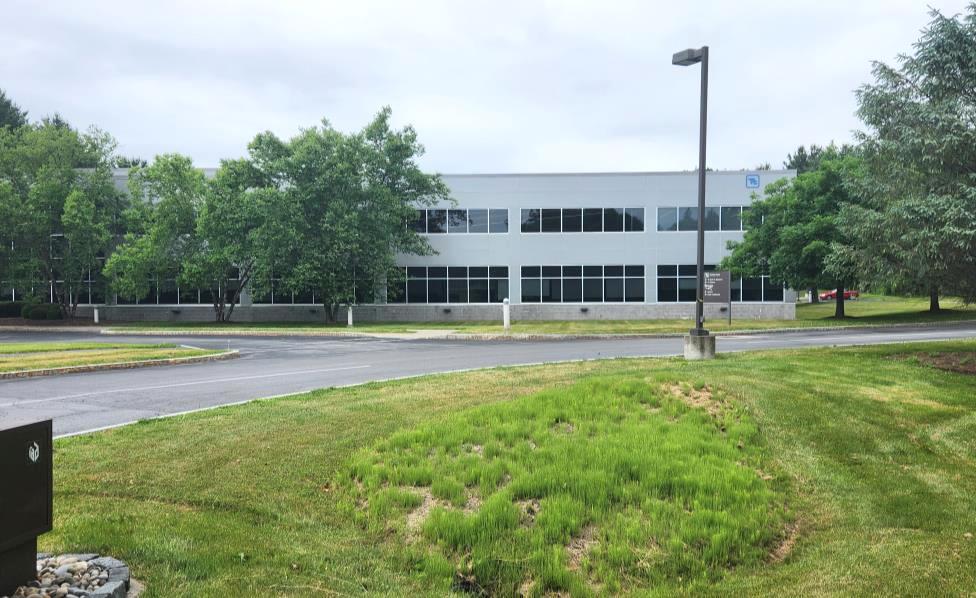
Legislator Brown points out Tompkins County currently has empty office space. And there’s a lot of additional space available near the airport; most notably at the expansive, 17-building Cornell Business Park, recently foreclosed upon by a local bank.
And because of that availability, the Enfield Town Board July 9th—with Brown seated in the room’s visitor’s gallery—urged Tompkins County to look at the Business Park and at other possible locations as an alternative to building a brand-new, $50 Million, 48,000-square foot Center of Government in the shadow of DeWitt Park in Downtown Ithaca.
“I’m not expert enough, my pay grade isn’t high enough, to tell the County what to do on this,” Enfield Councilperson Robert Lynch—this writer and the author of last Wednesday’s resolution—told Town Board colleagues that night. “But it’s just: let’s stop; let’s look at this; let’s look at these other options and see if maybe one of them is a better fit for us. I don’t know.”
Enfield’s recommendation to Tompkins County came less than a week after Tompkins Community Bank officially closed on its acquisition of the 17-building office park complex. And it did so at a bargain price approaching that of a fire sale.
Foreclosing on a mortgage lien of $75,454,000, Tompkins Bank bought the modern, low-slung properties for an even $50 Million, according to documents filed July third with the Tompkins County Clerk. The buildings, each built on land leased from Cornell University, had been held by a string of limited liability companies and other legal entities controlled by noted local developer Philip Proujansky.
County Clerk’s records show that the sale was completed on June 25th, with attorney Carl J. DePalma serving as the Referee. New York State and Tompkins County gained a whopping $300,000 in transfer taxes by the sale.
As officially known now, the 17, land-leased, bank-owned properties are owned by “Ithaca Tech Park LLC.”

Quoting DePalma, The Ithaca Voice July 11 reported that at the foreclosure auction, first scheduled for April 29, “the bank set the opening bid at $50 million and while other bidder pools were present, the bank ultimately won the auction.” DePalma declined to provide The Voice further details.
The Tompkins County Legislature, by a nine-to-four vote June third, made its firmest commitment yet toward building a Downtown Center of Government. Legislators resolved to approve “funding of up to $50 Million—through a combination of cash, debt and potential grant sources—for development of the Center of Government project to be located on the 300 block of North Tioga Street,” its resolution stated.
Both at that June Legislature meeting and at times thereafter, officials have differed as to how firm of a commitment the Legislature actually made when it adopted its resolution But Randy Brown was among the legislative quartet who dissented on the vote. And since the June resolution’s adoption, he’s become an increasingly outspoken critic of the downtown undertaking, that despite the fact that he chairs a special committee that would oversee a Center of Government’s construction.
“Our employees are important. But I think constituents are more important,” Brown told the Enfield Board this past Wednesday, “because they pay the bill.”
Only after Tompkins County had hosted a series of five “Community Engagement” meetings around the county in June—one of them June 12 in Enfield—sessions to explain the downtown project and take input, did information surface that County officials had conferred with the foreclosing financier, Tompkins Community Bank, about possible County purchase of one or more of the Cornell Business Park structures.

In a May 19th memorandum to legislators and key staff, County Administrator Korsah Akumfi had advised that the then-pending foreclosure had “prompted renewed discussion about potential alternatives to the downtown center.”
In what he described as an effort to seek “clear direction from the Legislature to ensure focused progress” on what he termed the “long-standing priority” of a consolidated office building, Akumfi in a three-page memo outlined the relative advantages and drawbacks of the airport-area office park location versus keeping with earlier plans to build downtown. On point after point, the administrator concluded that building downtown was better.
One Enfield Town Board member July 9th pointed to that conclusion.
“In this review, they obviously thought about it and they concluded in this memo that it didn’t make sense,” Enfield Councilperson Jude Lemke critiqued the Business Park option after having reviewed what Akumfi had written.
Legislator Brown’s opinion when asked for a reply: “I think the memo was quickly written to shut it down.”
Brown concluded that the County Administrator had drafted his memo with a purpose in mind; with intent to tip the scales in downtown’s favor, a position preferred by the Legislature’s majority.
“I think it’s because seven of these people, these legislators (most of them long-serving incumbents set to depart the Legislature at year’s end), they’ve been doing this for eight years, and they’ve had enough,” Brown concluded. “This is the third property they’ve looked at.”
When the Center of Government concept regained momentum in 2018, legislators first considered a site on the 400 block of North Tioga Street, a partially-vacant lot bounded by residences and a block away from the County Courthouse.

The Legislature bought that initial land—it still owns most of it—but later moved its collective attention away from it and saw commercial properties in Tioga’s 300 block as a better place for the building. That, too, Tompkins County purchased. And current plans call for deconstructing three mid-20th Century buildings on this latter location to make way for the Center of Government. Officials plan to break ground in early 2027.
Although some Enfield Town Board members expressed initial hesitancy on meeting night, the resolution “in support of expanded siting options for a Tompkins County Center of Government” passed unanimously.
“Resolved, that the Enfield Town Board hereby encourages the Tompkins County Legislature and Tompkins County Administration to consider seriously and thoughtfully various alternative siting locations for a Tompkins County Center of Government, alternatives including, but not necessarily limited to, buildings made available at the Cornell Business Park….” Enfield’s July 9th resolution states.
“I’m not sure myself whether they’re right for Tompkins County,” this Councilperson said of the business park buildings. “I don’t think that anybody right now knows if they would be a good, alternative fit for Tompkins County. But I personally believe they should be considered, and I didn’t know what other board members thought about that. ”
Opinions varied.
Supervisor Stephanie Redmond, somewhat reluctantly, gave the resolution her support. She’d attended the June engagement meeting in Enfield.
“There are a lot of benefits to not being downtown,” Redmond acknowledged. But “there are also understandable reasons why they want to have it all together for their own efficiency of their offices and their employees,” she added.
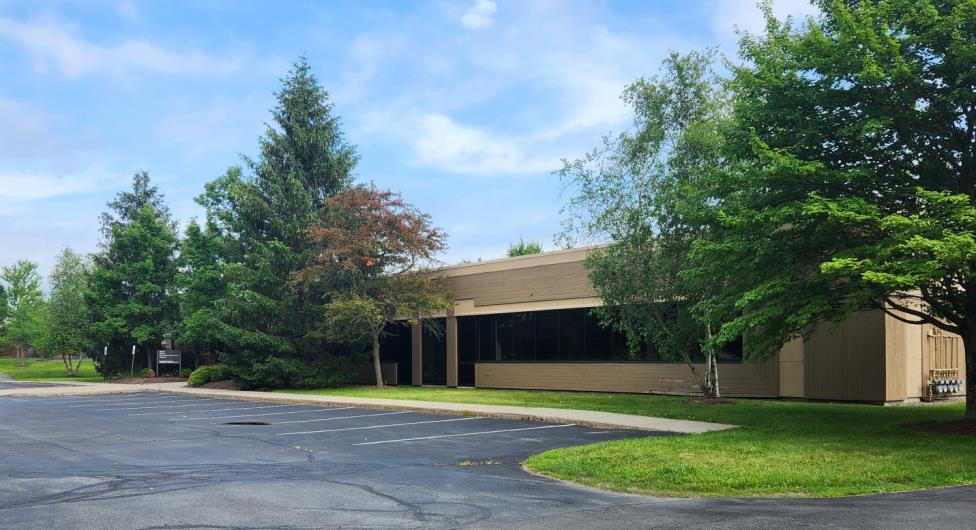
Initially during the Enfield Community Engagement meeting, Supervisor Redmond had strongly supported locating Center of Government offices in vacant one-time stores at the Shops at Ithaca Mall. But as the engagement session progressed, Redmond’s enthusiasm waned. Tompkins County representatives, including architects and engineers, steered the Supervisor toward keeping and consolidating Courthouse-reliant departments, including the District Attorney, downtown.
“From what I gathered at the meeting… it was a little of a ‘domino effect,’” Redmond said July 9th, “where you need to have the court where it is, you had to have the DA where the court is, and you need to have another office where the DA is, and then you need to have their office near a different office, because they all interact so much. That’s why they have this whole thing with the Center of Government being right at that spot downtown,” the Supervisor concluded.
Redmond’s—and many County officials’—logic holds value, yet only to a point.
True, the District Attorney and the County Clerk face state orders to vacate the Courthouse to give judicial staff more room. But there’s “The Old Jail” next door, and it could house the DA. And one of the current buildings slated for deconstruction—perhaps “Building C,” where the Board of Elections now resides— could accommodate the County Clerk.
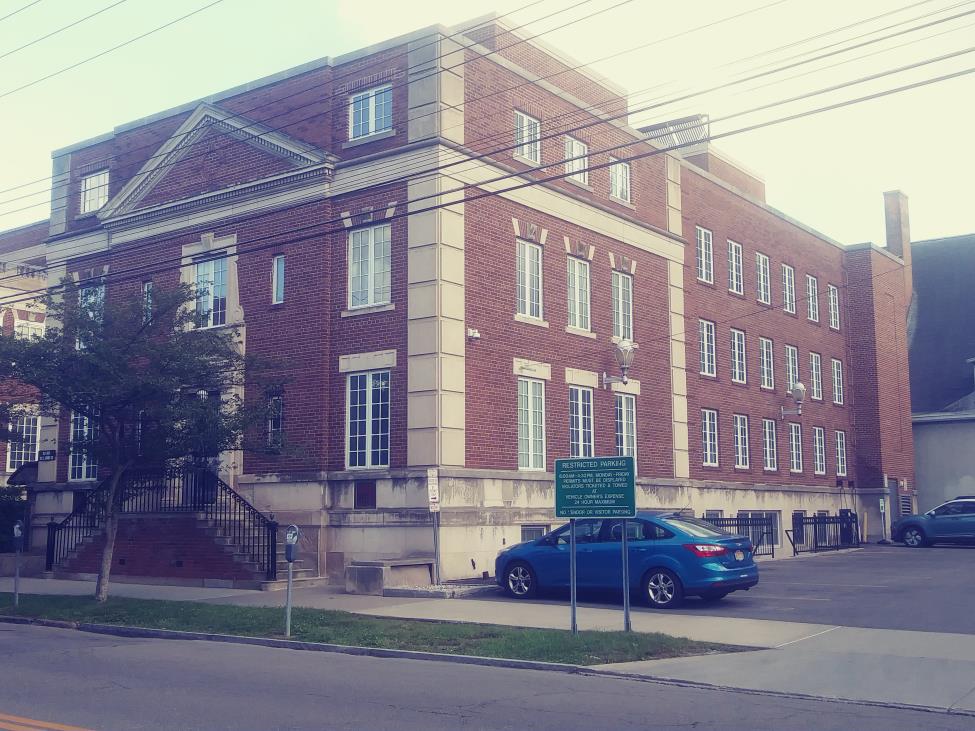
That row of tumbling dominoes could, indeed, be interrupted, providing, of course, that those in charge have the will to halt the tumble. The County Administrator, the Finance Office, and Assessment could easily relocate uphill. And as Randy Brown has said, the Office for the Aging has no business being in the downtown building. The office’s visitors are older, and downtown parking is hard to find.
Councilperson Cassandra Hinkle, nonetheless, wondered whether an out-of-the-way rural location could actually impede elder access.
“The biggest problem with elderly is lack of transportation,” Hinkle commented, “to take them to their appointments, and that’s a huge problem.”
But unless a county office remains within true 70-something walking distance, providing the older adult remains ambulatory, riding a TCAT or Gadabout bus to a business park or a mall-based location should become as handy as taking that same bus to downtown.
“There may be disadvantages there,” this Councilperson, Lynch, acknowledged regarding the Business Park option, “but I don’t like the idea that it’s just being arbitrarily dismissed and tossed off the table, just like I don’t like the idea that the Shops at Ithaca Mall is being tossed off the table.”
Enfield’s resolution urging a deepened look at Center of Government site selection next goes to the County Administrator and to each elected legislator. Randy Brown was handed his copy after Wednesday’s meeting. Again stated, Brown would prefer we use what’s already been built.
“Environmentally, it’s not a good thing, in my mind,” Brown said of starting fresh with a new, four-story downtown behemoth, “not to mention it costs $50 Million.”
It’s “worth looking at,” Supervisor Redmond said of what Ithaca Tech Park LLC has for sale.
“We need to broaden our perspectives,” this Councilperson concurred.
###
Free-phone policy faulted as ICSD Board reorganizes
by Robert Lynch; July 13, 2025
“I can think of a lot, lot, lot better ways to spend 80,000 a year that would directly impact kids.”
Ithaca Board of Education member Jacob Shiffrin, July 8th

Attempting to pick apart a $169 Million Ithaca City School District Budget can overwhelm the brain to the point of mental exhaustion. Buying a school principal’s cell phone with taxpayer money becomes a whole lot easier to wrap one’s mind around.
The Ithaca Board of Education at its organizational meeting July 8th revisited its current policy—and it will return to the policy again next month—of providing certain “select district employees” free cell phones as a benefit of their employment.
“Who do we provide cell phones to, why, and how much does it cost?” newly-elected Board of Education member Jacob Shiffrin asked fellow Ithaca City School District (ICSD) board members and staff that Tuesday. It was Shiffrin’s first question after taking his oath of office.

Zach Lind, Assistant Superintendent for Human Resources and Technology, was quickly summoned to the head table. Lind said he couldn’t provide exact numbers, but estimated “off the top of my head,” that Verizon charges about $60 per month for each employee’s “zero-cost phone,” and imposes a total annual bill to the district of about $80,000.
“I can think of a lot, lot, lot better ways to spend 80,000 a year that would directly impact kids,” Shiffrin reacted to the long-standing purchasing practice. “I’m shocked that we did this.”
Shiffrin, the only candidate from a three-person slate of reform-minded insurgents to win an ICSD board seat last May, said he’d talked with parents, principals, and teachers and “could list out right now 500 things” that would better support students than providing free cell phones to school personnel.
“I think we should not do this,” Shiffrin said of providing free cell phones to upper-level staff.
A resolution to continue the selective employee mobile phone benefit was sandwiched among nearly 40 mostly-routine organizational resolutions addressed by the Ithaca School Board during it’s three-hour Tuesday morning session. Of those many matters, the cell-phone resolution was among only one or two that grabbed significant attention.
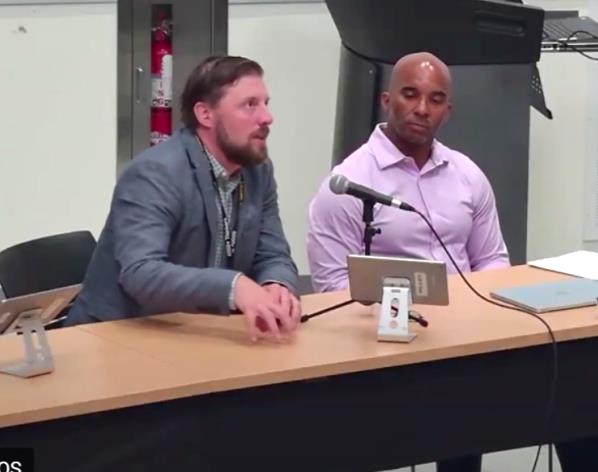
Halted in its otherwise hasty parliamentary pace, the board first tabled its vote on the cell phone matter until after a more than hour-long executive session, one during which the issue was predicted to come up. Yet when board members emerged from the closed conclave, they further tabled the cell phone resolution until their next session, August 12.
Questioned after adjournment to enumerate how many employees carry district-paid cell phones, HR and IT administrator Lind hedged. He declined to give a firm number until August. But working the math, based on the administrator’s estimated monthly rates and total cost, one arrives at an employee headcount of about 110.
“We’re providing cell phones to folks usually in leadership roles or really active service roles where they’re needed to be on call as part of their job, but they’re not always in a specific location,” Lind explained Tuesday to Shiffrin and to other board members. He used the Director of Facilities as one example, an administrator whose job takes him from building to building.
I’d “love to get out of the business of providing cell phones to employees,” School Superintendent Dr. Luvelle Brown acknowledged. But Brown admitted that “it gets rather complicated and challenging” to actually cancel the employee benefit.
This year was not the first time that employee cell phones gained scrutiny at the start of the official school year. It did last July as well.
“This has been kind of an annoyance for me for a while,” former Board of Education member Jill Tripp stated when the board reorganized on July first of 2024. ”I believe that the cell phone expenditure in the district is unwarranted and redundant, and I would like a further convincing explanation as to why we need to be providing cell phones to people.”
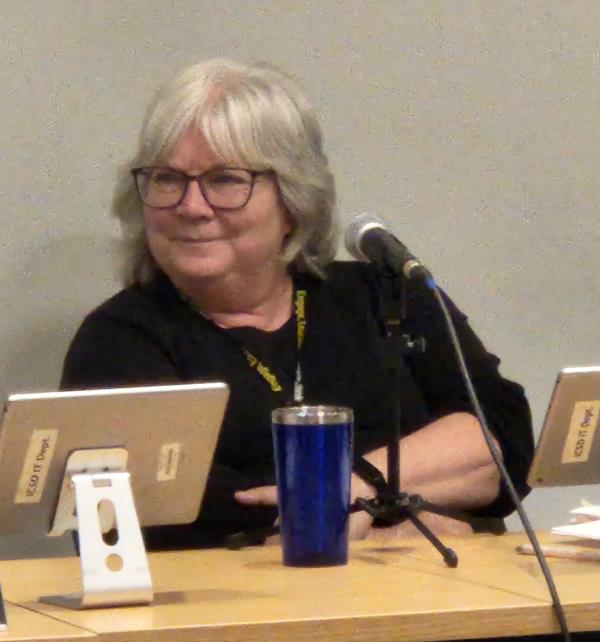
Dr. Tripp lost her bid for reelection last May, replaced, as fate would have it, by Jacob Shiffrin. And during her final year of office, Tripp never received the answer she’d sought.
“We really haven’t had conversations about it,” Board member Adam Krantweiss said of the cell phone policy at this more recent reorganization. “It is very expensive, and it seems like there are a lot of other options because everybody has a cell phone that they’re carrying around 24 hours a day,” Krantweiss pointed out. “We could purchase second lines. We’ve talked about all these different options before.”
“We have to take into consideration that our district employees may not want to use their personal cell phones for business purposes,” board member Karen Yearwood interjected.
And then there’s the argument of wanting to untether yourself from your job when off-the-clock.
“When we talk about mental health, being able to turn off your work phone on a vacation or whatever is critical,” board member Erin Croyle remarked.
“It keeps coming up; it’s been coming up; it will continue to come up,” Board President Sean Eversley Bradwell acknowledged. “But I don’t want us to think that just because we’re taking away cell phones that there will not be an additional cost,” he cautioned.
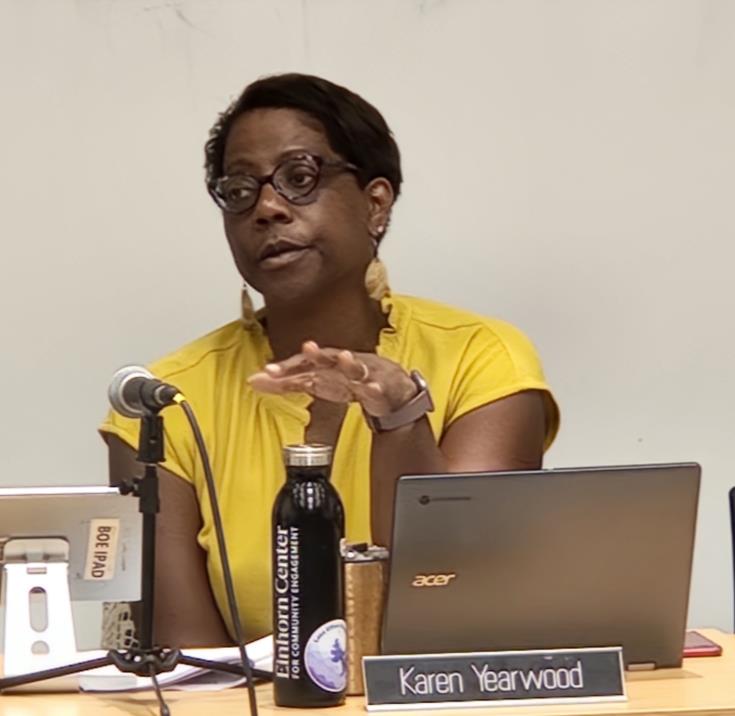
Eversley Bradwell said the cell phone benefit may be “a negotiated item,” with some employees. Yet when Shiffrin asked whether it’s a contractual obligation, the board president declined to say.
If cell phones aren’t provided, “stipends” might be needed to compensate key staff for the business use of their personal devices, Shiffrin was told. And there’s a legal argument. If one’s job-related duties result in a lawsuit, could the individual’s phone and of all of its contents—business and personal—be subpoenaed as evidence?
“Personal phones could be “foilable,” Eversley Bradwell warned. Some board members thought the district’s legal counsel should weigh in.
Superintendent Brown claimed that ICSD taxpayers shoulder only about $20,000 of the $80,000 cell phone expense. Federal rebates pick up the remaining cost, he said. The discussion never ventured into what would happen if Trump-era austerity cancels those reimbursements.
But the recurring question of cell phones as an educational perk demonstrates once again that when it comes to governmental spending, it’s the little things that count the most. The cell phone expense totals less than five-one hundredths of one percent of this year’s ICSD budget. But it’s like last year when the district’s rental of high-tech “clocks” for all school buildings—admittedly more costly an investment—raised heightened taxpayer concern.
Expect the cell phone issue to rear its head again August 12, when the Ithaca Board of Education next meets.
****
Picking the Ithaca Board of Education’s new leadership for the twelve months ahead proved smoother this year than last. Whereas last year’s election for Board President and Vice President went through multiple rounds, this year’s elections resolved themselves on the first ballot.
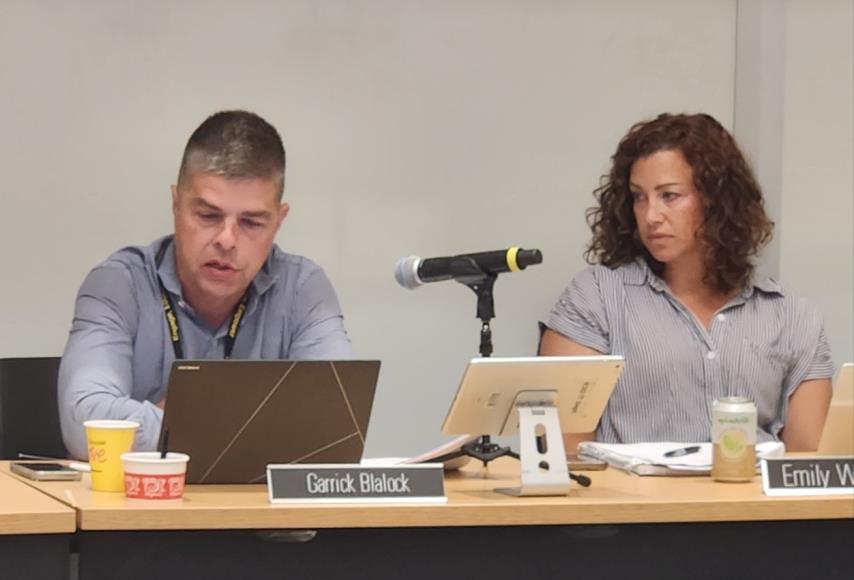
Without opposition, Sean Eversley Bradwell was reelected Board President. Employing a new secret ballot procedure adopted quietly during the past year, Garrick Blalock succeeded Adam Krantweiss as Vice President, beating fellow board member Emily Workman, five votes to four.
Prior to the vice presidential ballot, neither Blalock nor Workman drew ideological lines between each other. Blalock stressed that he’d attempt to avail himself of Eversley Bradwell’s “expertise” and “absorb the knowledge he’s acquired over the years” in the expectation that Eversley Bradwell’s current term as Board President may be his last.
What mattered most for Enfield parents and students that day might never have gotten reported had not a keen reporter kept an eye to last-minute agenda changes with full knowledge of the vacancy list.
Inserted as an “addendum” to its Personnel Report following its one-hour, 20-minute executive session, the board promoted Stephen Anderson to become Principal of Enfield Elementary School. It also elevated Tara Caiza to become Principal at Fall Creek Elementary.
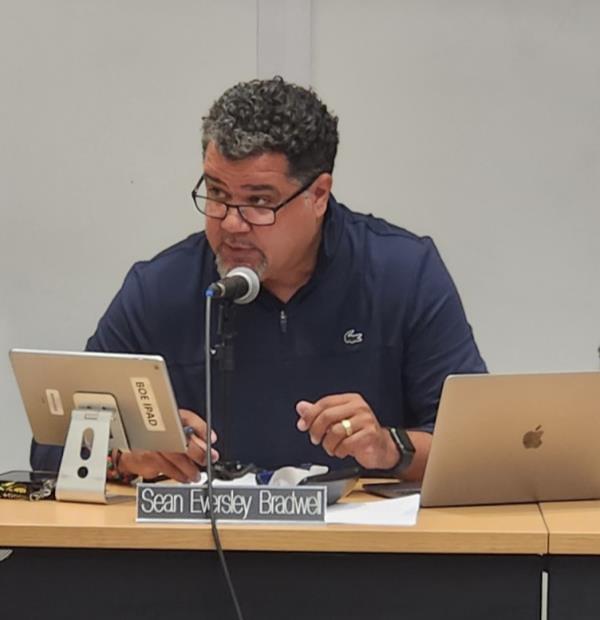
Anderson joins Enfield having served this past year as an “Educator of Inclusion” at Boynton and DeWitt Middle Schools. Caiza served as the Associate Principal at Boynton.
For reasons unknown, each promotion got exceedingly low-profile treatment. Neither appointee’s name was ever mentioned at the meeting.
Stephen Anderson succeeds Enfield Principal Keith Harrington, whom the district recently transferred to become Principal at the Lehman Alternative Community School.
Later Tuesday, in an open letter to Enfield parents, Anderson wrote:
“Enfield Elementary is a joyful and vibrant learning community, surrounded by fields, orchards, and outdoor spaces that invite wonder and exploration.”
Enfield’s newly-appointed Principal continued, “I look forward to learning from the amazing work already happening here, especially the integration of equity, sustainability, and community partnerships that define Enfield’s identity as an edible, equitable, farm school.”
###
Posted Previously:
Sudden Storm Socks Enfield
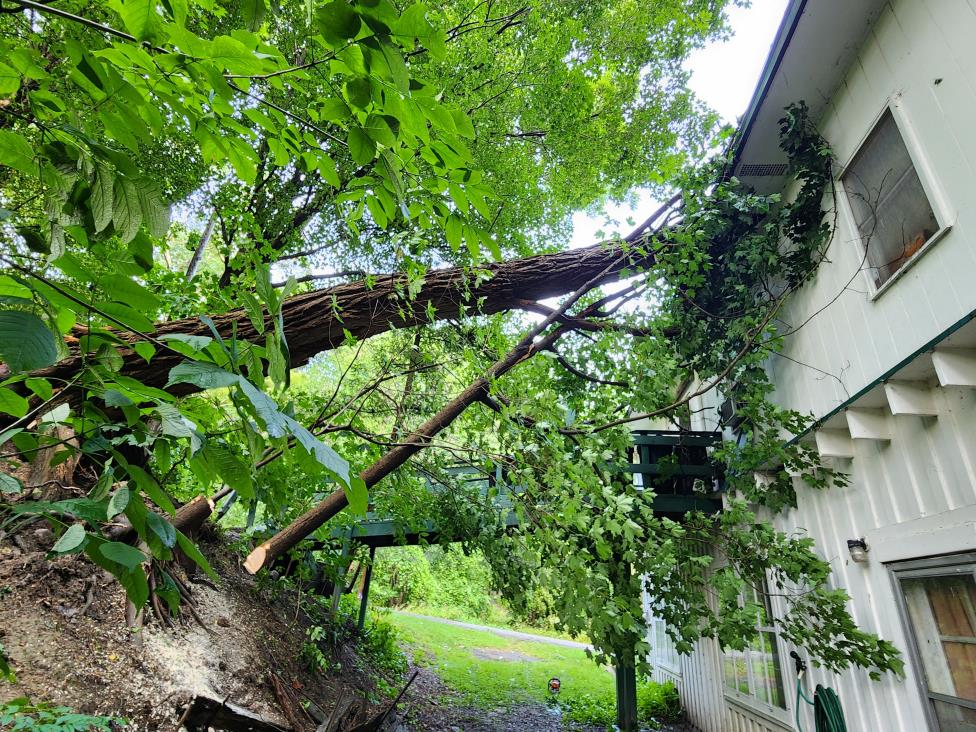
by Robert Lynch; July 4, 2025; updated 2:20 PM
A firefighter whose name you’d know stood alone in the Enfield Fire Station when the National Weather Service sounded the alarm July third: “Tornado Warning for Southwest Tompkins County in central New York…. TAKE COVER NOW! Move to a basement or an interior room on the lowest floor of a sturdy building….”
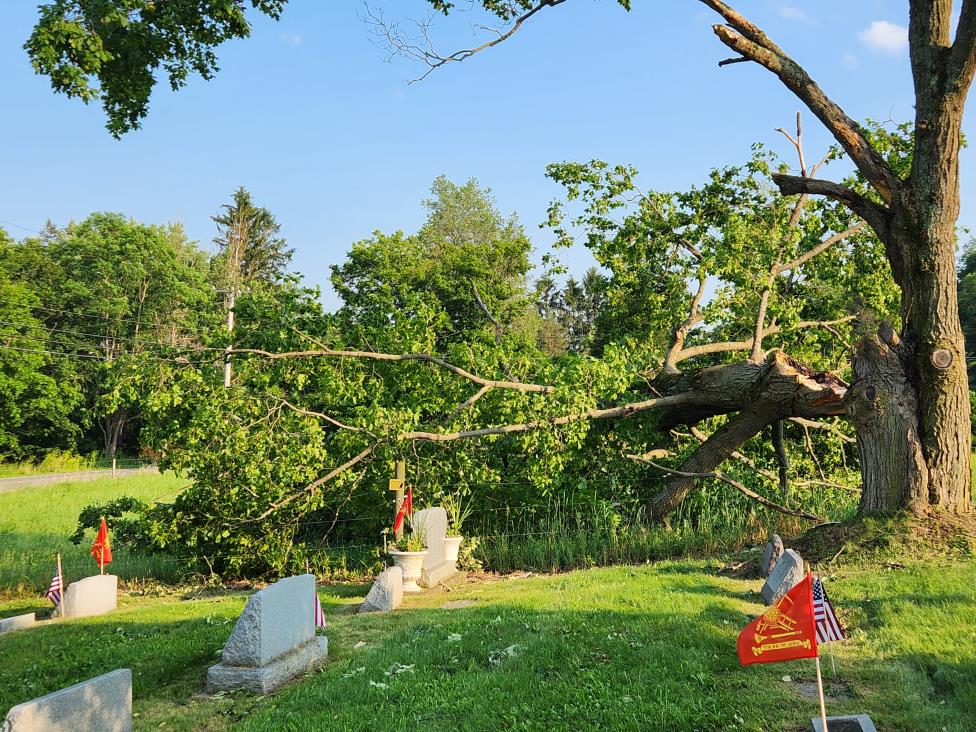
“What was I to do?” the seasoned firefighter asked herself. The fire station may be sturdy, but it has no basement. A whirlwind could quickly peel off the metal roof and leave her and everything else exposed. Then what? “Maybe I should crawl into that fire engine behind me,” she later recalled she’d asked herself. Perhaps the safest place at that moment was inside that rugged, spanking-new Truck 602?
Shelter-in-pumper never proved necessary. As best anyone knows, there never was a tornado. But there was a bad storm; the worst so far this Enfield summer. It came up from seemingly nowhere. It was gone within an hour. But when it raged it was fierce, downing trees, snapping power lines, damaging a handful of homes, and in its aftermath forcing the re-routing of busy highway traffic onto narrow country roads well into the night.
“It was pretty intense,” Enfield Volunteer Fire Company (EVFC) First Assistant Chief Kevin Morse Jr, the company’s Chief-in-Charge at the time, said of the calls that came in and the responses needed. The toughest time came in the first 90 minutes after the 2 PM storm hit, he said. Crews needed to lend support to different sides of Enfield simultaneously, Morse explained.
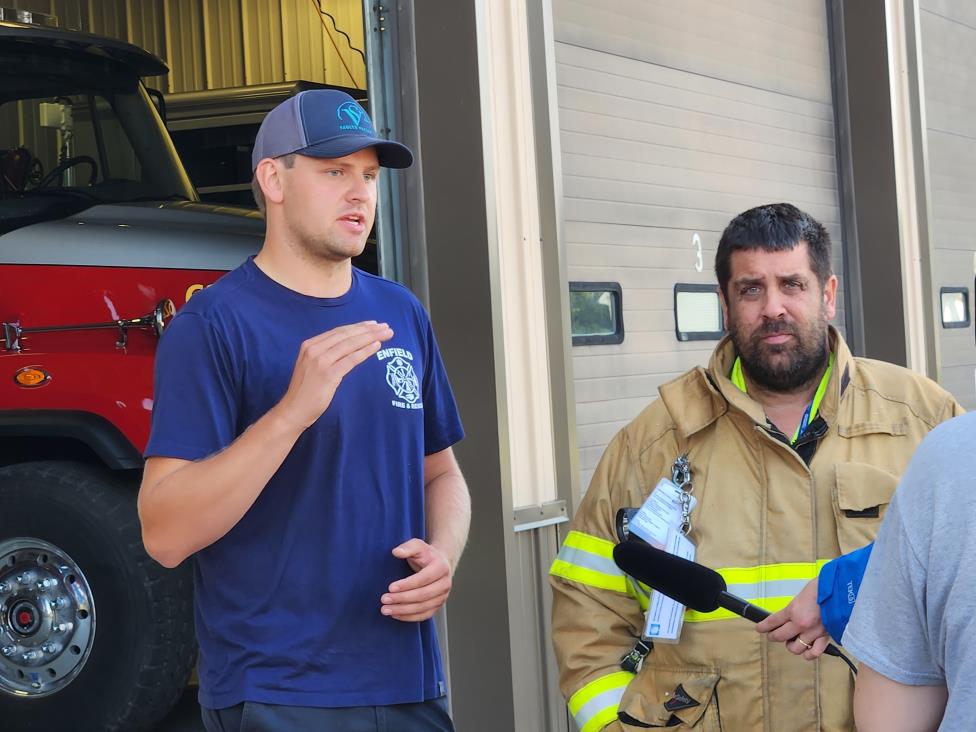
Enfield responded to 14 calls during that period, Fire Chief Jamie Stevens reported. Twenty-six additional calls came for storm-related emergencies in other parts of Tompkins County, Stevens indicated.
No injuries or fires occurred, the fire chief said. The EVFC responded to two instances of trees falling on houses. In one instance a fallen tree briefly trapped an elderly Applegate Road woman in her home.
Buildings may have sustained damage, yet none were apparently destroyed.
A giant locust fell upon the roof of John and Paula Meeker’s home at 576 Van Dorn Road South, causing roof damage, but not forcing the Meekers to flee.
At the southern edge of Enfield’s Christian Cemetery, the storm tore off a big maple limb. It fell into an adjacent field, causing no damage to the cemetery.

Power remained out for many into the evening. A trio of tree-related power line breaks along Mecklenburg Road (NY Route 79) near the intersection with Rothermich and Podunk Roads left that highway closed until nearly nightfall. All of Enfield Center and Miller’s Corners lost power for hours. The Dandy Mart closed. The Enfield Fire Station was forced to run on back-up generator power.
Kevin did “an outstanding job,” Chief Stevens told a television interviewer at the fire station Thursday evening as to Morse’s coordination of rescue efforts.
Enfield Board of Fire Commissioners member Robyn Wishna also took pains to commend the many Enfield residents who’d pitched in during the hours after Thursday’s storm to clear debris, direct traffic, and otherwise assist emergency crews.
“One man took his skid loader to push limbs out of the way,” Wishna reported.
The National Weather Service’s initial report, issued at 1:45 PM July third, indicated that the storm that later caused Enfield’s damage was located in Mecklenburg and was moving southwest at 40 miles-per-hour. That initial report warned of a “Tornado and half-dollar size hail.”

The weather service’s prediction of a possible tornado based its conclusion on the observation that “radar indicated rotation.”
After tearing up Enfield, the storm moved east into the Town of Ithaca. There it produced the biggest traffic snarl.
Downed trees and power lines north of the Eddydale Farms produce stand prompted the mid-afternoon closure of all Route 13 traffic between NY Route 327 and Five Mile Drive.
Emergency crews redirected the heavy, pre-holiday Route 13 traffic along a circuitous, poorly-equipped, country road detour. It employed Town-maintained Gray and Colegrove roads, the latter currently undergoing reconstruction. The detour continued until past Midnight.
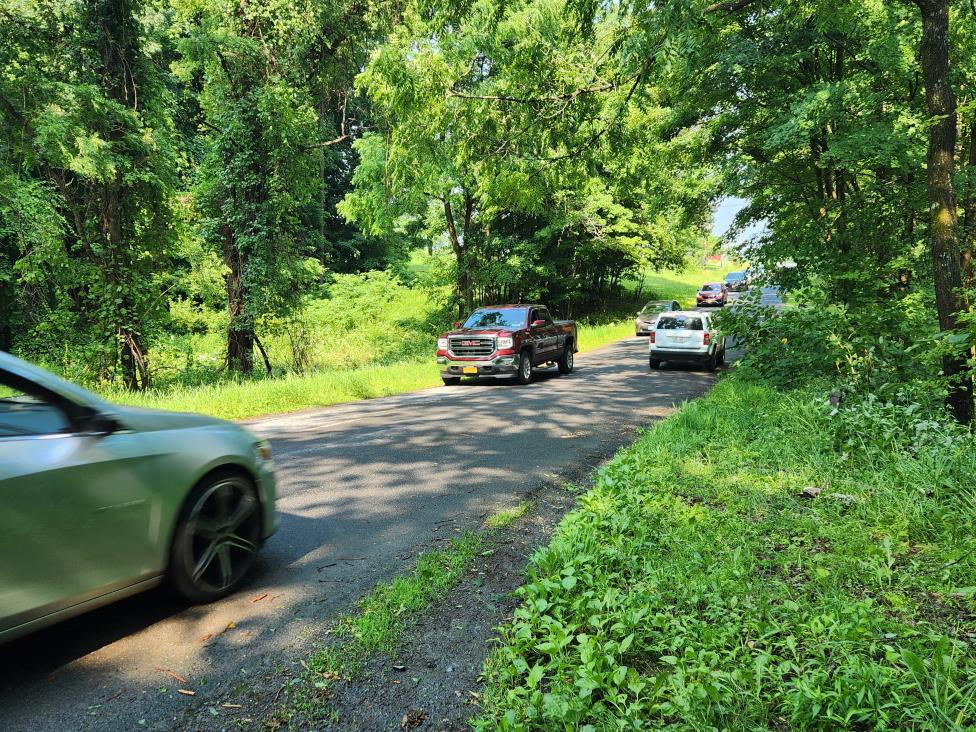
Homes and businesses in the City of Ithaca by and large escaped damage equivalent to that sustained in Enfield. But inconveniences occurred, nonetheless. Power outages forced some businesses, including the Ithaca Wegmans, to operate on back-up generator power. The store cut electrical usage, leaving eerie, dimly-lit aisles for shoppers to navigate.
While Thursday’s storm proved destructive, it did not rise to the severity of the July 15th storm last year that left some customers without power for up to two days, prompted Enfield’s Supervisor to spearhead the distribution of dry ice, and spawned as many as 455 emergency calls to the Tompkins County 911 Center, reportedly its highest single-day volume of calls in a decade.
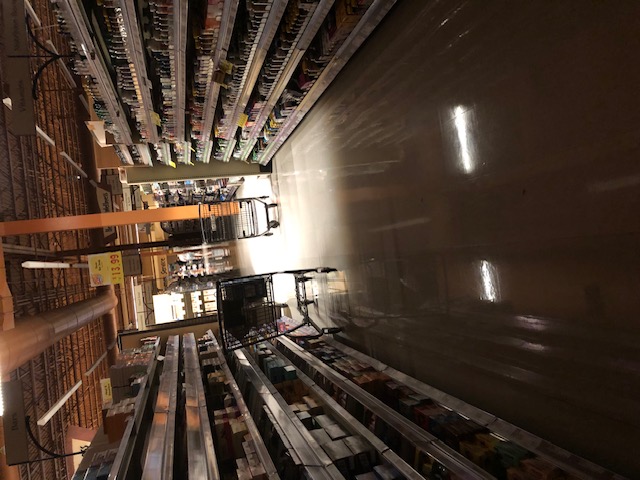
The 2024 storm also prompted the EVFC to update its emergency dispatch procedures, inadequacies that led to confusion, redundancies, and delayed responses that day. In the days and weeks that followed, Chief Stevens took the lead in correcting the deficiencies.
The magnitude of power outages from this year’s Thursday storm varied. NYSEG reported as many as 3,610 customers in the county lacked power as of 4:30 PM Thursday. The utility initially predicted power to most would be restored by 5 PM that day. It wasn’t.
As of Noon on Friday, July 4, NYSEG reported 294 Enfield-area customers still without power, the outages scattered among nine locations. The largest outage, affecting 135 customers, was along western Bostwick Road, with restoration scheduled for early Friday evening. The second largest outage, affecting 87 customers, ran along Applegate Road North near the Ulysses town line.
The same storm that walloped Enfield also produced destruction to the East, including in the Binghamton area and on to the Delaware River valley.
###
Posted Previously:
Tompkins’ “Thornwood Option”
Foreclosed buildings near airport could house Center of Government… but probably won’t.
Reporting and Analysis by Robert Lynch; June 27, 2025

“[It’s] a high-risk and potentially more expensive alternative.”
Tompkins County Administrator Korsah Akumfi; May 19
“It just feels different than downtown… There’s room to breathe. Compare that to being crammed all-too-tightly into a four-story, downtown box.”
This writer; just now
View it, if you will, as an opportunity too good to pass up. That said, Tompkins County will likely toss it aside.
A cluster of office buildings near Tompkins County Airport, modern, low-rise structures comprising what one expert calls the largest real estate foreclosure in Ithaca history, fleetingly grabbed attention from Tompkins County leaders this spring as an alternative to building a $50 Million Center of Government in Downtown Ithaca, newly-released documents reveal.
But after a quiet, shrouded review, officials recommended lawmakers give the option a pass.
In his previously-undisclosed May 19 memorandum to local legislators and key personnel, Tompkins County Administrator Korsah Akumfi reported that his office’s officials had talked with banking representatives about buying the multi-building, airport-adjacent complex. Akumfi made public his three-page memo June 25 after a Tompkins County legislator had alluded to the acquisition inquiry during a public meeting the night before.

Tompkins Community Bank, which had foreclosed on a private developer holding ground leases for the properties, had offered to sell County Government all of the 18 foreclosed buildings for an eight-figure amount.
“The bank is seeking to sell all 18 properties in a single sale, at an estimated cost of approximately $55 million,” Akumfi advised legislators. “The land acquisition is unclear at this point,” the County Administrator reported.
Cornell University owns the ground on which the buildings sit. The land forms part of the Cornell Business Park, located along Brown Road, Thornwood Drive, Brentwood Drive, and Arrowwood Drive in the Town of Lansing.
Ultimately, however, after performing a cost and feasibility study, Akumfi recommended against the building purchases, either collectively or a la carte.
“While the Cornell Business Park option presents intriguing elements, current occupancy levels, acquisition costs, lack of long-term control over the land (ground lease), uncertain rehabilitation requirements of 2-3 buildings, and potential operational disruptions make it a high-risk and potentially more expensive alternative,” Akumfi concluded. Instead, the administrator steered lawmakers back to their original plans to build the Center of Government in downtown Ithaca.
“The downtown Center of Government project remains a viable, strategically sound, and carefully planned investment in the future of Tompkins County,” Akumfi counseled.
Korsah Akumfi, Tompkins County’s Administrator since only January, has since his hiring become vocal and impatient about moving ahead with the downtown project. He’d prepared the downtown-versus-Business Park comparison, in part, to prod legislators to act. Lawmakers followed the administrator’s advice earlier this month and provided the Courthouse-adjacent building site a heightened commitment.

By a nine-to-four vote June third, the Legislature adopted a resolution that “approves funding up to $50 Million… for the development of the Center of Government.” The resolution further directs that the office building is “to be located on the 300 block of North Tioga Street,” downtown.
Never during any discussions prior to the early-June decision did administrators or legislators publicly reference the Cornell Business Park’s properties or their availability. Should Administrator Akumfi’s analysis have received legislative attention, the discussions would have occurred in closed session.
In the opinions of some, the Legislature’s vote June third firmly commits Tompkins County to build the Center of Government downtown, and that there’s no turning back. On the other hand, Newfield-Enfield legislator Randy Brown, chair of a special committee that’ll oversee the construction, advised the Enfield Town Board June 11 that in his view the Legislature’s decision is not “irreversible.”
No one might have learned that Tompkins County had seriously—albeit briefly—searched for an alternative Center of Government site had not Lansing legislator Mike Sigler referenced it during an otherwise-uneventful Community Engagement meeting Tuesday, June 24. Tuesday’s was the final of five governmentally-sponsored sessions convened about the county to explain the Center of Government project and to take public comment concerning the building’s potential design and downtown desirability.
“We looked at other locations as recently as, I think, two months ago,” Sigler advised attendees Tuesday, referencing in only vague terms an inquiry that had never before been stated publicly.
“There was a big foreclosure up at the airport,” the Lansing legislator stated.
“There were a bunch of buildings that are coming up for sale,” Sigler continued. “Korsah did what I felt was a pretty in-depth investigation of how—if we could do that. We already have a footprint up there, so it does make a lot of sense. We have the Health Department up there.”

But then, Sigler conceded, opportunity yielded to (presumed) financial reality.
“But when he ran through the numbers,” Sigler said of Akumfi’s analysis, “the numbers, they were what they were, and they were relatively close to what this building seems to be costing us downtown.”
The cost of a Downtown Ithaca Center of Government has become a nagging irritant; a source of public concern, if not derision. The longer the project’s been considered, the steeper its price has climbed.
In some way, shape or form, a Center of Government, a common structure to house under one roof as many of Tompkins County’s widely-scattered departments as possible, has incubated in legislative minds for two decades or more. When the concept gained new life in 2018-19, the center’s construction was priced at about $20 Million. As that momentum has grown this decade, the cost estimates have climbed as well; first to $32 Million, then to $40 Million, and just recently to $50 Million.
“I’ve heard estimates for a Center of Government building between 45 Million up to 70, and that just seems like… entirely too much money to pay when you have buildings you can use as they are now,” Zach Winn, a former Ithaca mayoral candidate and current Republican candidate for Ithaca Common Council, told Tuesday’s Community Engagement meeting.
When Winn referred to “buildings you can use as they are now,” one presumes he referred to those Tompkins County already occupies, not those clustered near the airport that government might later buy.
“Is this really the best use of like $50 Million?” Winn further asked about the planned downtown investment. “There’s commercial property all over the place.”
Surprising as it may seem, the mammoth foreclosure on what amounts to an entire office park near the airport has found a knack for evading media scrutiny this spring.

“I believe this is the largest real estate foreclosure in Ithaca’s history,” Costa Lambrou, general manager of Ithaca-based Lambrou Real Estate, told The Cornell Daily Sun in April.
Indeed, the Cornell student newspaper’s April 16 story was one of the few reports to document the mammoth bank foreclosure that’s thrust the Cornell Business Park properties onto the market.
The foreclosure impacts only the privately-owned buildings atop the university-owned land, not the land itself. The defaulting developer holds long-term ground leases.
According to the Cornell Sun’s report—confirmed by court records—Tompkins Community Bank initiated a foreclosure action in January 2024 against a group of limited liability companies associated with private developer Phil Proujansky.
According to the paper’s report, Tompkins Bank’s law firm, Harris Beach Murtha Cullina, stated that the bank initiated foreclosure after “the borrowers, real estate LLCs linked to Proujansky defaulted on a $68 million mortgage by failing to make payments since September 2023.”
A marketing and communications manager for Tompkins Community Bank declined further comment to the Cornell Daily Sun in April regarding the foreclosures.
With the bank apparently having taken control of Proujansky’s building assets at the April 29 foreclosure auction—no further documents are on file with the Tompkins County Clerk—Korsah Akumfi in his May 19 memo stated that his office had held “recent discussions” with “representatives of the bank holding bonds tied to the Cornell Business Park.”

During those private discussions, Akumfi said he’d learned that among the 18 involved properties (some court records list the number as 17), 80 percent are currently occupied. One building, a sprawling one-story structure at 33 Thornwood Drive (pictured above), is fully vacant, the memo stated.
“The bank has expressed a willingness to sell the buildings individually,” the County Administrator’s memo reported. ‘[H]owever, the County would need to either share space and assume the role of landlord for the existing tenants or negotiate their relocation,” he cautioned
As for the renovation expense to adapt the Proujansky structures to County use, “Rehabilitation costs are currently unquantified, presenting significant unknowns in terms of required investment,” the Administrator qualified.
Although some may cite it as a “worst case” example, Administrator Akumfi drew upon Tompkins County’s history with its Health Department Building—also resting atop Cornell-owned land within the Business Park—to caution of financial pitfalls that could lie ahead.
Tompkins County had purchased the Health Department building for Three Million dollars, negotiated a 100-year ground lease with the University, but then had to pump $10 Million more into renovations to make the property suitable, the Administrator stated.
“These factors raise concerns about the feasibility, timeline, cost certainty, and operational impacts of relocating or expanding into Cornell Business Park,” Akumfi concluded.
The Administrator’s side-by side comparison of costs-versus benefits gave downtown siting the benefit of the doubt, as Akumfi saw it. Nonetheless, the analysis, viewed critically, stretched objectivity at times.
Akumfi contrasted a Downtown Center of Government’s projected construction cost ($42-50 Million) with the $55 Million Tompkins Bank is asking for all of its the foreclosed buildings, not just the few that County Government may need.
A Downtown Center of Government would provide 48,000 square feet of space for departments. The 18 Business Park buildings would offer an area far greater. And five of the bank’s 18 structures, those on Brentwood and Arrowwood Drives, are separated far from the rest. They’re on the opposite side of Route 13. Many lease to medical providers.
The comparison skews other realities. The administrator identifies downtown’s timeline as “Ready to Proceed,” but warns that occupancy of buildings in the business park would be “delayed by tenant relocation and negotiation.” The latter observation stands true. But the comparison also ignores the fact that three existing structures on the downtown site will need to be razed, “deconstructed” before any new building can break ground..
A final criterion applied by the Administrator describes a new building downtown as in “complete alignment” with Tompkins County goals, whereas any repurposed facilities would achieve only “partial alignment.” How administrators reached their subjective conclusion the memo fails to explain.
But nowhere does the administrator’s memo address what stands as the Business Park’s prime attribute; its supply of ample, free parking spaces for both employees and visitors.
Parking spaces downtown are scarce. And feeding Ithaca’s parking machines costs money. A downtown-sited Center of Government may in the future—like Tompkins County’ downtown offices have in the recent past—require employees to pay to park most of the workday, presuming, that is, they can find a parking space. Visitor parking could become an even greater challenge.

Public commenters at this month’s Community Engagement meetings have repeatedly raised the parking issue. Project consultants have so far lamely attempted to blunt that criticism with their excuse that a parking study remains underway, but is not yet done.
More importantly, however, Akumfi’s side-by-side comparison ignores a subjective criterion that may override all others. You may not be able to grasp the difference unless you actually drive and walk the Cornell Business Park (as this writer did). It just feels different than downtown. There are trees. There is grass. There’s open space. There’s room to roam freely within a modern, well-manicured office campus. There’s room to breathe. Compare that to being crammed all-too-tightly into a four-story, downtown box.
Thinking expansively—and creatively—Administrator Korsah Akumfi and the Tompkins County Legislature could make their campus-like, open-air Center of Government in Lansing the envy of leaders in many other places.
“I’ve also heard from some of our staff,” Shawna Black, County legislator, told the engagement session. “They believe that we’re building this building too small, and that we’re already outgrowing the 40,000 square feet that you guys (the architects) are proposing.”
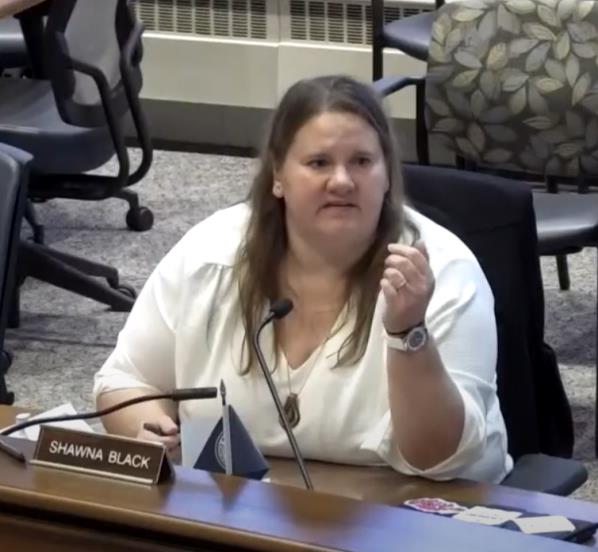
Legislator Black was among the nine lawmakers who’d backed proceeding with the Center of Government June third and keeping it downtown. She raised a second warning flag about the downtown location this more recent Tuesday night. It addressed that parking question:
“If we don’t have places for our own employees to park, for people that are going to visit us to come and park, then I’m not sure I would actually be in favor of this project,” Black warned, thereby qualifying her previously-made downtown choice. Black’s newfound caution underscores the fragility any legislative commitment to downtown may hold.
Nevertheless, even to Mike Sigler, the inevitability of a Downtown Center of Government appears to have sunk in, even though he’d declined to lend his vote to the project just three weeks earlier.
“We have a Legislature of 14 people,” Sigler reminded those at the June 24 Engagement Session. “Whether I agree that it should be downtown or not is not irrelevant,” he said. “But the votes are that most people want to see this downtown.”
“I would really like us all to just be committed to the downtown location because I think we already voted on that,” legislator Veronica Pillar, an Ithaca City resident, said with a degree of impatience. “It’s a little late to stop that train.”
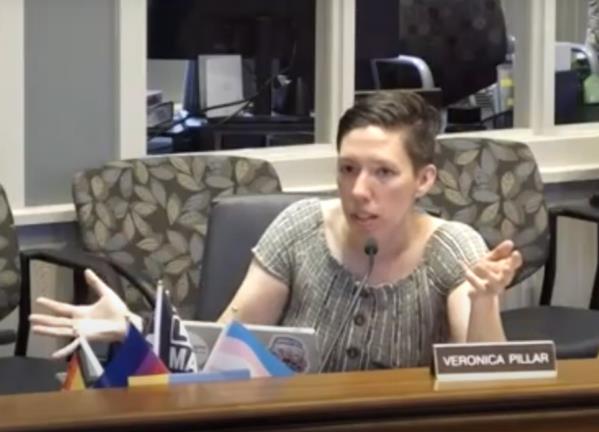
Administrator Akumfi thinks the way Dr. Pillar does.
“It is important to note that continued indecision incurs cost, diverts staff capacity, and delays necessary improvements in government services and infrastructure,” Korsah Akumfi wrote in his May 19 memo.
“I’m pleased that we’re moving ahead,” Dryden’s Mike Lane, a big supporter of the Center of Government and its planned downtown footprint, said as the engagement session wound to a close. Lane related tales from a century earlier about how Tompkins County’s Main Courthouse got built.
“There’s probably no good time to spend $50 Million at the county level,” Lane conceded. “But I think when they look back in the future, they’re going to be glad that we built the building because it will be a building that’s going to be there for 100 years, or more, and it’s going to service the people of the whole county.”
Public turnout for Tompkins County’s five Community Engagement sessions to discuss and dissect the Center of Government has not been great. Community attendees at each meeting numbered only in the handful. Tuesday’s session in Legislative Chambers ran just 52 minutes, whereas an hour and a half had been set aside. Tompkins County’s Communications Director pleaded for comments that often never came. The June 24th forum drew only four spectators, this Enfield Councilperson included. Among the public, only Zach Winn and I chose to speak.

“There are people who do not find downtown very inviting,” Winn warned legislators. “And I think that is a justified perspective,” he observed.
“We’ve got to realize there are options still on the table, and I would like to see those options pursued,” this writer advised the dozen or so elected and appointed officials who’d assembled that night to hear what the public had to say.
Just three minutes later Mike Sigler would reveal what some may call the “Thornwood Option,” the once-considered fallback alternative pondered by leaders in recent weeks, but only in the shadows. After Sigler spoke, how much more meaningful—albeit, unknowingly on point—this speaker’s earlier admonition had suddenly become.
###
Posted Previously:
From T-Burg kid to Health Commissioner
Jennie Sutcliffe appointed; vows to guard against Trump-Kennedy cuts
by Robert Lynch; June 18, 2025
You’ll never accuse Jennie Sutcliffe of backing down in a fight. At least that’s the lasting impression one got from hearing the Trumansburg native’s acceptance speech June 17 after the Tompkins County Legislature unanimously appointed the animated, highly-credentialed policy advocate as its newest Commissioner of Whole Health.
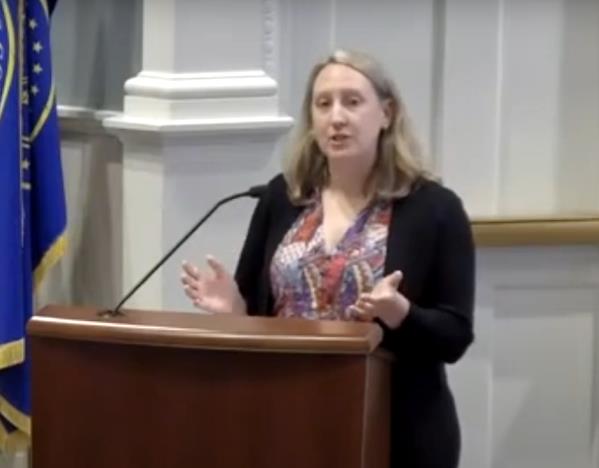
“(It’s) what I’ve sort of been calling meeting the political moment,” Sutcliffe told the Legislature as she embraced her appointment Tuesday. “We need to be playing defense to really defend the work that we’re doing and prove why it is important, but also to play offense,” Sutcliffe said.
The new administrative hire explained why a defensive posture requires offense as well..
“It feels a little bit silly to think that it’s important to be forward-looking right now,” Sutcliffe acknowledged. “But if there are systems that are dismantled and if we lose funding, and programs have to stop someday, we will have the chance to rebuild those again, and we don’t want to be caught flat-footed when that happens,” she explained. “So I think it’s important to be thinking defensively, but also a little bit offensively in this moment as well.”
Jennie Sutcliffe was one, but not the only Tompkins County department head the Legislature appointed Tuesday.
With much less fanfare, and relegated to the end of a four-hour meeting—which included an hour-long Executive Session—legislators promoted Deputy Finance Director Darrel Tuttle to become Director of Finance. Tuttle succeeds Lorrie Scarrott in leading the funding-focused department. Scarrott is retiring following two years as Finance Director.
Both Jennie Sutcliffe and Darrel Tuttle will assume their new positions July 7.
In her three-minute address to the Legislature, during which she showcased her administrative priorities, Jennie Sutcliffe never mentioned the two federal officials whose take-no-prisoners policies hold the greatest impact over local health services delivery, namely President Donald Trump and Health and Human Services Secretary Robert F. Kennedy Jr. Though not named, the collective shadows of Trump and Kennedy loomed over Sutcliffe’s words. Change must be expected became the appointee’s overarching message. Ill-advised reforms should be resisted when possible; but then services once lost can be restored and enhanced when political skies brighten.
Two other goals the newly-hired commissioner has set for herself, she said, are “building trust” among staff, decision-makers, and the larger community; and “supporting our resilient workforce,” people within her department.
“You know, I understand that this is a time where being in government isn’t the same as it used to be,” Sutcliffe admitted to the Legislature. “So we really need to do a really good job and continue to do a good job of demonstrating our value and what we bring to our community, both here in Ithaca and in Tompkins County as a whole.”
Jennie Sutcliffe is no stranger here. But like many who claim Tompkins County as their anchor, the woman who grew up as a girl in Trumansburg, left for a while to pursue her career in larger places. And then she returned.
“I can say without a shadow of a doubt that we chose an incredible candidate,” legislator Shawna Black proclaimed as she put Sutcliffe’s name into nomination to become Commissioner of Whole Health.
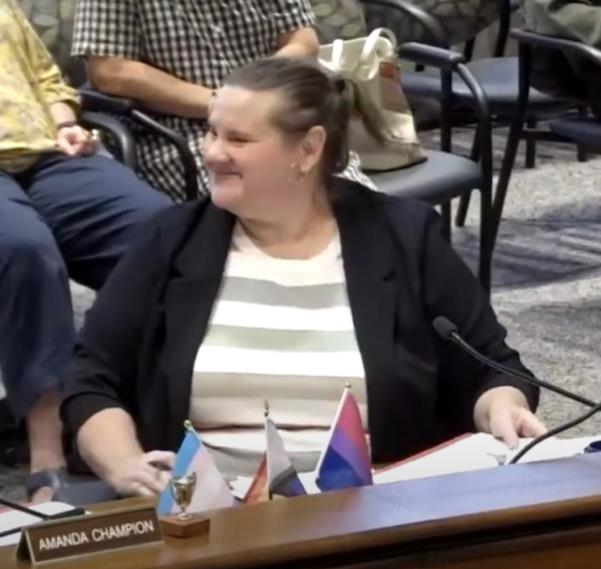
Giving prominence to their collective pride in choosing a person with such impressive credentials, legislators elevated Sutcliffe’s appointment to near the top of Tuesday’s agenda.
“Ms. Sutcliffe brings over a decade of robust experience in public health leadership, emergency preparedness, health policy, and cross-sector collaboration,” a news release posted the following morning by Tompkins County’s Communications Director stated.
“Since 2018, she has served as a Senior Advisor in the Office of Emergency Preparedness and Response at the New York City Health Department,” the release said of Sutcliffe’s credentials. “In that role, she led the strategic planning and implementation of the department’s Response Ready initiative and served in leadership positions during multiple public health emergencies, including directing quarantine and isolation operations during the Mpox response and leading COVID-19 incident command initiatives such as vaccine operations and personal protective equipment distribution,” the release stated.
Jennie Sutcliffe’s resume also includes her serving as a Senior Policy Analyst in the New York City Health Department’s First Deputy Commissioner’s Office. In that position, the news release touted, Sutcliffe “influenced Medicaid and healthcare policy and led multimillion-dollar pilot projects focused on social determinants of health.”
A former Fulbright Research Scholar who studied in Italy, Sutcliffe holds a Master of Science in Philosophy and Public Policy from the London School of Economics and Political Science. Before taking the position in New York City, the newly-hired Whole Health Commissioner held positions in Chicago, including serving as a Health Justice Policy Specialist under Illinois’ then-Governor, her task “focusing on Affordable Care Act and Medicaid implementation for justice-impacted populations,” Tompkins County’s news release stated.
Maybe that last-stated effort stood out more than anything else in getting Jennie Sutcliffe her job.
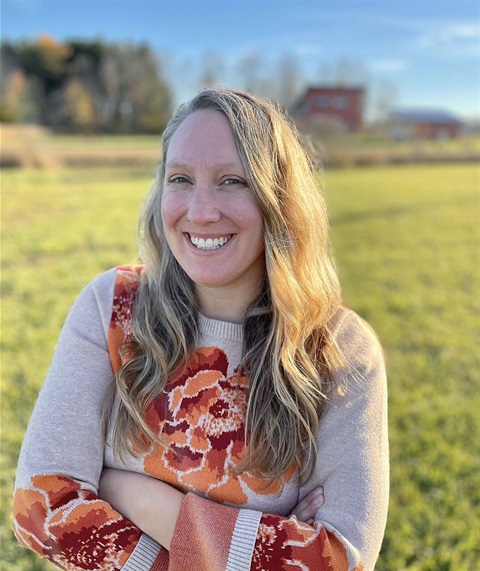
“The one thing that was very clear during her speech to us was that she has a real vision for our department, and her focus on health equity was something that I think is going to be really important for our community,” legislator Shawna Black said in moving Sutcliffe’s appointment.
Jennie Sutcliffe steps into a hybrid administrative structure that may look better in theory than it works in practice.
In 2023, after four years of study that began pre-pandemic, the Tompkins County Legislature merged the Tompkins County Health and Mental Health departments into the Department of Whole Health. The Public Health Department deals with physical illnesses, dog bites, vaccinations, and tasks as mundane as septic system approvals. Mental Health addresses, as its name implies, mental illnesses.
The 2023 merger saved hiring a separate administrator. But Health and Mental Health occupy different buildings, their locations widely-separated. And New York State administers the divisions separately, such that their combination required special consent. In some respects, as the state views it, Whole Health is an administrative oddity.
Even though Tompkins County’s Board of Health and the (Mental Health) Community Services Board had each affirmed the appointment prior to Tuesday’s legislative vote, Sutcliffe’s confirmation “is currently pending final approval from the New York State Department of Health for her designation as Director of Public Health,” the Communications Director’s release states.
Expect Albany’s ratification to stand as a formality.
During the COVID-19 pandemic, the Health Department side of the subsequently-merged administration, gained stature—lots of it—as the County Legislature reserved former Health Commissioner Frank Kruppa ample speaking time at each, twice-monthly Legislature meeting to update lawmakers on COVID case numbers, testing protocols, and vaccination opportunities.
In mid-January of this year, Frank Kruppa resigned as Commissioner of Whole Health. He assumed a position with Cayuga Health Systems, the local hospital corporation, as its Assistant Vice President for Community Program Development and Partner Integration.
In accepting her own appointment, Jennie Sutcliffe, noticeably animated and outgoing, expressed excitement about her incoming role in Tompkins County Government.
“I grew up in Tompkins County. I grew up in Trumansburg,” Sutcliffe said. “And although I moved back to the area a couple of years ago, my work has remained elsewhere, and so I’m really thrilled to be able to work in my own community again, and this feels like a real homecoming,” Sutcliffe gushed.
****
Much more subdued was the end-of-meeting appointment of Darrel Tuttle as Tompkins County’s new Director of Finance.
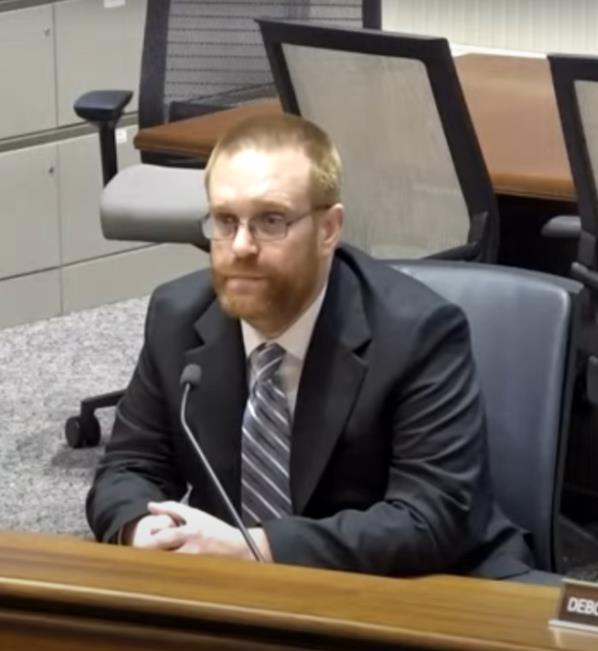
Finance directors lack the public visibility of health commissioners. They don’t fight disease, but they do keep governments humming—and solvent. Finance directors monitor sales tax receipts. They assess budget balances. And particularly in departing director Lorrie Scarrott’s case, they initiate investment strategies that earn the county cash.
“I want to thank you for the opportunity,” Darrel Tuttle told legislators, after Chairman Dan Klein invited him to speak at meeting’s end. “This marks my third year working for Tompkins County in a couple of different roles, the appointee, now Deputy Finance Director, said.
“I look forward to better serving the Legislature, the County, and serving with my staff as I go into the new role as Director of Finance,” Tuttle concluded.
Tompkins County took strides Tuesday to close its longer-than-usual list of administrative vacancies. But the gap-closing remains far from finished.
Shortly after Health Commissioner Kruppa tendered his resignation, Kit Kephart in January revealed her plans to retire this July as Commissioner of Social Services. Then in early-May, County Highway Director Jeff Smith announced his retirement plans. The selection process for those pending vacancies continues.
###
Down by DeWitt, or Out at the Mall?
Enfield weighs Tompkins’ leaders pitch for a Center of Government

Reporting and Analysis by Robert Lynch; June 16, 2025
Turnout wasn’t great. County legislators and staff outnumbered attendees. And as many as half of those who did accept the open invitation were local municipal leaders. One woman brought her toddler.
At the Enfield Community Center Thursday, June 12, Tompkins County convened the second of its five, first-round “Community Engagement” sessions to describe and gauge public support for a $50 Million proposed Center of Government, the four-story office building Tompkins County wants to build in Downtown Ithaca, overshadowing DeWitt Park..
That said, perhaps the most telling question asked—and then answered—came not at Thursday’s engagement session, but rather one night earlier. That’s when Randy Brown, one of Enfield’s two county representatives and chair of the committee that oversees the project, got tossed a question at the Enfield Town Board’s meeting concerning a purported commitment given the pricey building by the County Legislature eight days earlier:
“Do you see the decision made last week as basically irreversible; that we’re going ahead with the building regardless?” this writer/Town Councilperson, Robert Lynch, asked Brown during his legislative update.
“No,” Randy Brown replied quietly, yet firmly.
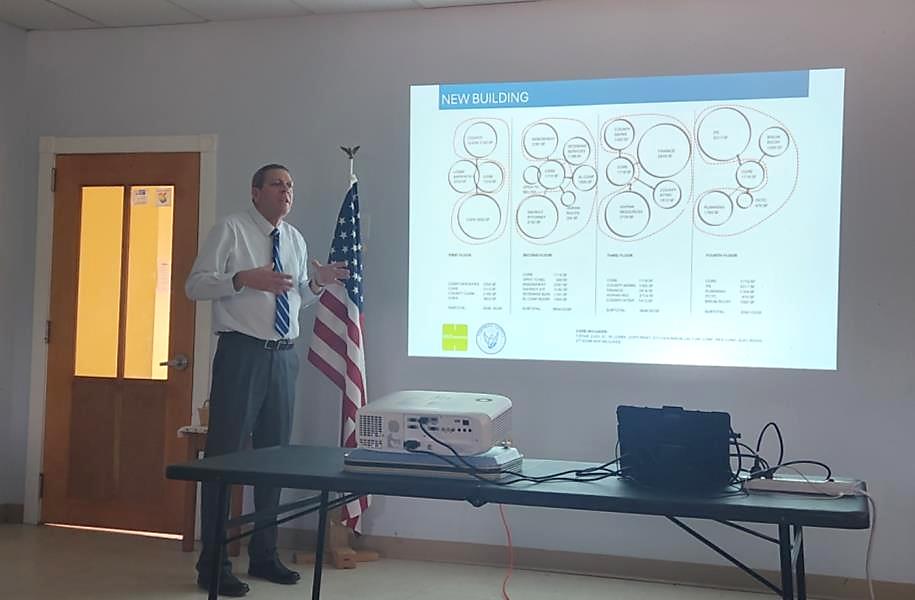
“That’s reassuring to hear,” this Councilperson responded. The Center of Government’s cost, its placement, and fiscal worthiness has given this Town Board member jitters since the day it was conceived.
That said, those who promoted the Center of Government at the Enfield Community Center’s session the next night would have preferred us to regard their big, pricey, downtown brick building as a done-deal. Yet reminded of Brown’s appraisal, and pressed to put facts behind their positive spin, leaders from County Administrator Korsah Akumfi on down acknowledged Thursday that political promises so far have fallen short of the assurances needed to break ground with confidence.
“I’m excited about this project,” Akumfi exclaimed at the engagement session. Akumfi’s office would be on the building’s third floor.
“We haven’t pulled the trigger yet, but we’re moving in that direction,” Dryden’s Mike Lane, the County Legislature’s longest-tenured member, said of a project. “We’ve been looking at it for at least 25 years,”
Arel LeMaro, Tompkins County’s Director of Facilities, equated the Center of Government’s design to a “slow-cooker crock pot.” How is that analogy drawn? “It smells nice, but it needs that time to simmer,” LeMaro said. “This is the time.”
Maybe… or maybe not.
The Tompkins County Center of Government sometimes resembles a lost commuter that’s passed through too any turnstiles. It’s done so for two-decades.
First conceived at the start of the millennium, and then, again, in about 2009, the Center of Government was once judged too expensive to build.
When former County Administrator Jason Molino and legislators revived the building project from dormancy a couple years pre-pandemic, plans then called for placing the structure a half-block down Tioga Street from the Courthouse. The building would stand where an orthodontist’s office was removed and a gravel parking lot now blemishes the neighborhood.
In 2021, after two years of Molino-supervised secrecy, Tompkins County walked the building’s footprint closer to the Courthouse. The County purchased both the former Key Bank at the Buffalo-Tioga Street corner, and the multi-attorney “Professional Building,” best known as Walter Wiggins’ former law office next door.
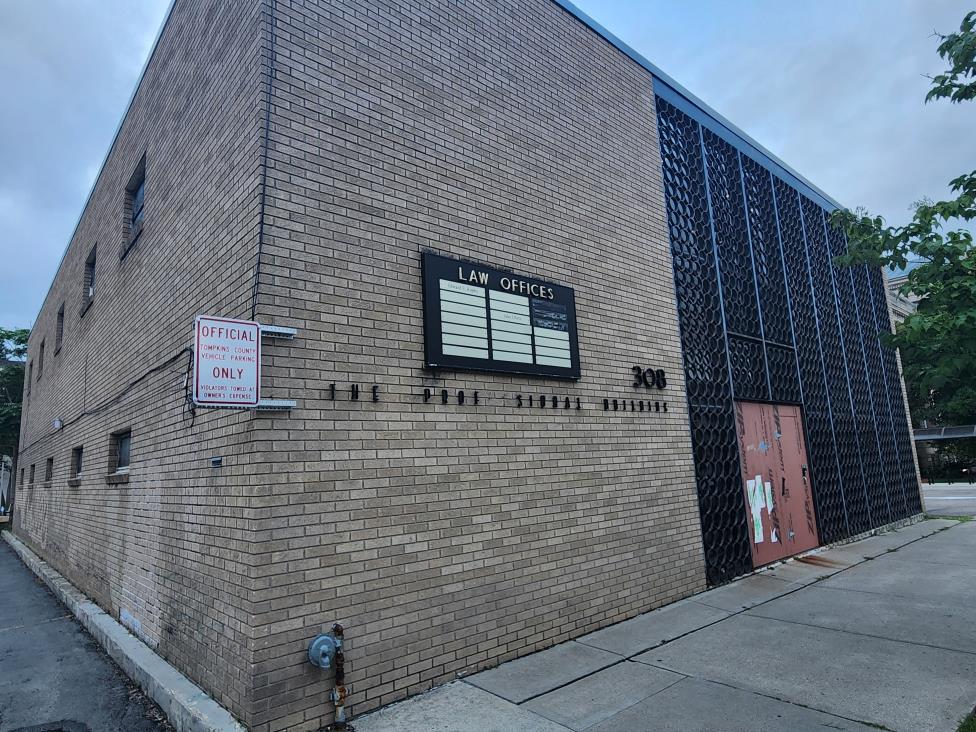
Since the combined $3 Million purchase, legislators have fixated on putting the Center of Government at the Buffalo-Tioga corner. The County-owned Board of Elections and Assessment offices—so-called “Building C”—would also be razed to accommodate the new edifice.
Infrequently, though not often—and indeed, less often as time goes by—some lawmakers have mentioned the prospect of siting the Center of Government “in a cornfield, ”as they quip; that is, on cheaper, vacant land far away from downtown. Alternatively, they might place it in surplus commercial space, like within Lansing’s increasingly-vacant Shops at Ithaca Mall. Many who lead us, however, greet that kind of rural-focused fallback option with derision. They consider it a non-starter.
But Enfield may look at choices differently. At least it seemed that way this past week. It could be that the farther one ventures from the courthouse block to Tompkins County’ rural reaches, the more one’s mind expands to embrace the ideas that others would discard.
“Go with the mall,” Supervisor Stephanie Redmond exclaimed, as the Enfield Town Board discussed Center of Government siting at the end of its monthly meeting June 11. “Everybody show up. Tell them you want them at the mall,” Redmond encouraged those who’d listen. In this instance, the Supervisor might be new to the issue, yet quick to direct action.
“I agree with you; I’ve been pushing this for a year,” this Councilperson, Robert Lynch, informed the Supervisor. “Unfortunately, it falls on a lot of deaf ears.”
One night later, at the community engagement session, Redmond reiterated her position; though later backed away from it a bit.
“I don’t want to be a wet blanket here,” Redmond cautioned meeting organizers, those who clearly favor a downtown location. But “we have a mall that is dying and falling apart,” Redmond observed of the Ithaca Mall’s ghost town persona. “What’s going to happen there?’ the Supervisor asked. “I hate to see excess space.”
“From my point of view, downtown property is very high value,” Redmond appraised real estate reality. It makes more sense, she argued, to locate at the mall “and give a life to a space that is dying.”
And to that comment, Tompkins County officials regrouped. They countered with an argument that holds some weight, yet only when taken no farther than it deserves to go.
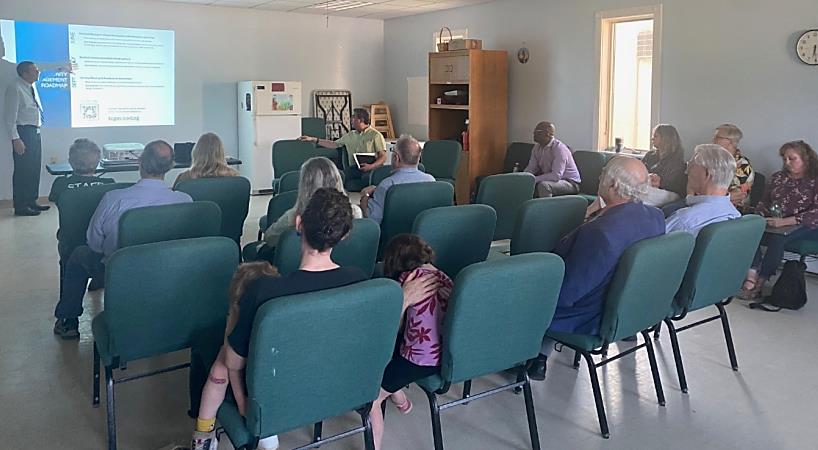
Criminal prosecutors, defense attorneys, and all sorts of legal staff need to locate close to the Courthouse, County officials reminded Redmond. The District Attorney’s Office should remain only a brisk walk from the courtroom, they said. So should the office for Assigned Counsel. The County Clerk’s Office benefits from being handy to those accessing records or filing papers, the argument continued. Close proximity supports the case for downtown co-location, they maintained,
Upon hearing the counter-argument, Redmond altered course.
“You made a good case about why it has to be down by the Courthouse,” Enfield’s Supervisor acknowledged. She confined her remaining inquiries to topics more restricted, such as whether Tompkins County should reserve some visitor parking spaces for expectant mothers or those with young children, or whether building construction would demand a “local labor component.”
Given that the Ithaca Commons was reconstructed largely by out-of-area workers, Redmond said, “It makes it almost a mandate to use local labor.”
“We can look at that,” Enfield’s second Tompkins County legislator, Anne Koreman, told the Supervisor.
While Supervisor Redmond may have retreated from her out-from-downtown preference, this writer, Councilperson Lynch, the only other Enfield Town Board member in attendance that night, held firm.
The state may have served Courthouse eviction notices to the District Attorney and County Clerk, this Councilperson acknowledged, but nearby alternatives exist for them to relocate. There’s the Old Jail next door. There’s Building C, or maybe one of the structures Tompkins County purchased four years ago and would otherwise “deconstruct” to accommodate the new building.
As many as 13 Tompkins County offices would relocate to the Center of Government. Most require no Courthouse proximity.
For example, Human Resources would relocate in the new building. That sounds like a wise move. Yet remember that many employees will remain scattered elsewhere. A Highway laborer headquartered off Bostwick Road or a Health Department nurse based near the airport may find a personnel office quartered downtown a pain to visit, not more convenient.
And some Center of Government relocations may be downright inappropriate.
Tompkins County’s Office for the Aging would move from its storefront location at State and Albany Streets to the Center of Government. Legislator Brown singles out that relocation as particularly inapt, unsuited for older adults challenged in their pursuit for downtown parking.
“My biggest concern is access for constituents, how it impacts rural people,” Randy Brown told the Enfield Town Board. “How important it is for the residents in Newfield and Enfield to park there,” to have access, especially to “front-facing” services like the Office for the Aging.
In evaluating opinions among the 13 people who now represent Tompkins County in our Legislature, Randy Brown’s objections stand out. Here’s why.
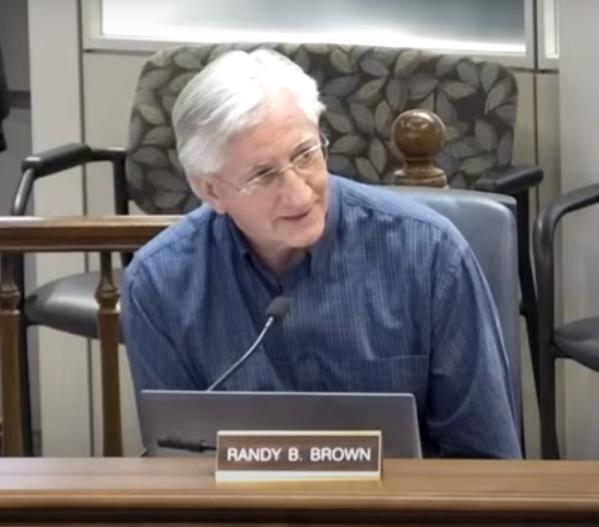
Brown chairs the Downtown Facilities Special Committee, the committee that oversees the Center of Government project. On the morning of June third, Brown joined all other committee members in recommending County Government “commit” to the project and also, presumably, to fund it. But that evening, only a few hours later, Brown joined other legislative Republicans and Ithaca Democrat Travis Brooks to oppose a similarly-worded Resolution on the Legislature’s floor.
It wasn’t a flip-flop, Brown explained to the Enfield Town Board eight nights later. It was only that he believed the full Legislature needed to decide the matter. His committee support took it there.
“I don’t feel comfortable with our capital plan,” Brown told the Enfield Board June 11. And as to the building, he said, “It’s going to raise taxes. It’s going to happen.”
“I think it should be smaller,” Brown said of the downtown building’s footprint. “There are all these unknowns.”
“Size of the building is still up in the air,” Brown told the community engagement session one night later. The legislator then quietly left early to give his monthly report to the Newfield Town Board. (Because of the schedule conflict, Newfield government proved under-represented at the ECC event, even though the meeting was intended to serve all three of our county’s western-most towns.)
“It’s not a done deal yet,” County Administrator Akumfi qualified Thursday as to the project’s status.
Legislative math may back up the administrator’s equivocation. The “Approval of Funding” commitment resolution cleared the Legislature by a nine-to-four vote June third. All legislative seats come up for election this November. A recent resignation has left one current seat vacant. And the Legislature will expand to 16 members come January.
Randy Brown, Lee Shurtleff, and Travis Brooks, each who voted against the commitment resolution, stand unopposed for reelection. The fourth objector, Republican Mike Sigler, faces an opponent in the fall, yet still holds the edge to win another term. They’ll each likely remain onboard into next year.
Meanwhile, among those who voted in the commitment resolution’s favor—all Democrats—only three (legislators Black, Mezey, and Pillar) will likely return. The remaining six plan to retire. Nine fresh faces could prompt deference next year to hesitant critics like Brown, Brooks, and Shurtleff.
Back some 16 years ago, when Tompkins County briefly flirted with building a Center of Government on the Old Library site, Joe Mareane served as Tompkins County Administrator. Mareane famously scuttled talk of a Center of Government with the words “I can’t make a business case for it.”
This Councilperson resurrected the Mareane bottom-line reality check argument at the Enfield Board June 11.

“There’s a good question whether we should build it at all,” I told Town Board members. “Nobody’s made a business case for it that I can tell. Nobody’s said, ‘This is how much we save; this is how much it’s going to cost; we would save more than it costs.’”
“Joe was right,” legislator Mike Lane acknowledged the next night at the engagement session. “But things have changed a lot,” Lane insisted. He sought to blunt the “business case” argument.
“The Great Recession was happening then,” Lane explained. And since 2009, there is more staff; more programs, he said. “Joe Mareane had one deputy. We now have two. They have to have desks,” Lane countered the fiscal argument of cold-hearted calculation.
Bernard Best, Holt Architects’ Project Manager for the Center of Government, fielded questions about design specifics at the ECC meeting. Public-facing offices like the County Clerk would be on the ground floor, he said.
Assessment, the District Attorney, and the Grand Jury room would be one flight above. The Administrator, the Finance Office, and Human Relations would occupy floor three. The Planning Department and Information Technology would occupy the top floor.
The project manager emphasized design economies within the 48,000-square foot building, touting the “synergies of shared space.”
Somewhat startling, Bernard Best said there are no plans right now to dig a basement. He mentioned flood plain concerns.
“All of these have heavy security,” Bernard Best referenced to the floors of offices, citing the District Attorney’s floor in particular.
But what does “heavy security” actually mean, this Councilperson quizzed the project manager? Will it be a “buzz-in” system, like several county buildings already have? Or will there be more intrusive magnetometers and bag searches? How “user-friendly” will this new building be, Best was asked? He couldn’t say. The level of security is under a consultant’s study, was all he cared to state.
At past legislative and committee meetings, Groton’s Lee Shurtleff had warned of a Center of Government finding itself strained for space as soon as it’s built. With that worry in mind, would the building be built strong enough to hold up a fifth floor, if added later? The project engineer said it would be.
And what about connecting the new building to the Courthouse, a thought no one’s considered to date? “There is a thing called winter,” this Councilperson reminded everyone.
Bernard Best cautioned that historic preservation concerns at the landmark Courthouse argue against an above-ground causeway. But he then acknowledged that a subsurface tunnel to the Courthouse might work.
Newfield’s Liane DeLong was among the few unelected local residents who attended the engagement session at the ECC. DeLong raised parking and traffic concerns that continually challenge a downtown location. She also argued against adding that someday-fifth floor.
“It feels claustrophobic,” DeLong said of Ithaca’s newly-obscured downtown skyline. “It upsets me now. I hate it. So many are taller and taller and taller. Pretty soon we won’t be able to see the sky.”
Tompkins County has three more Community Engagement meetings scheduled this month to solicit comment on a proposed Center of Government. A meeting June 16 at the Dryden Village Hall will be followed by a session in Caroline one week later, and then a final forum at County Legislative Chambers June 24. Only the one in Chambers will be live-streamed.
Two further community meetings—but only to be held downtown—are planned for July and September as project plans advance. We may see a design sketch by late-summer.
That is, unless plans change abruptly by then, and we all simply head to the mall. But don’t count on it. Cooks hate to turn off the slow cooker when the soup’s so close to done.
****
Postscript (June 16): Tompkins County held the third of its five Community Engagement meetings on the Center of Government project Monday night, June 16, this time in Dryden.

As with the earlier session in Enfield, resident turnout was sparse. County officials again outnumbered public attendees. But unlike in Enfield, no one in Dryden questioned whether Tompkins County should actually build the $50 Million office complex. Nor did anyone suggest an alternate site location, such as at the Shops at Ithaca Mall.
Questions posed during the 90-minute Dryden meeting—many from County staff and lawmakers—instead centered on space allocation within in the new building; provisions like bathroom facilities , lactation rooms, and even whether the new building’s windows would open to let in fresh air.
Dryden’s Mike Lane and Greg Mezey represented the County Legislature Monday, the only two from the body to attend. Both members June third had voted to support the Center of Government.
Mike Lane said he wants a building that “complements, but does not overpower” its neighborhood; “something the whole community can be proud of,” he said.
Project Manager Bernard Best confirmed that architects plan to present three different building design options to the public, thereby giving people the opportunity to pick which one they prefer. / RL
###
Two Enfield roads eyed for slower speeds
Town Board also moves Subdivision Regulations off the dime
by Robert Lynch; June 13, 2025
Question: What’s the quickest route to Newfield or Elmira from Trumansburg—or for that matter, even from Waterloo? It’s not through traffic-clogged Ithaca. Instead, think Halseyville Road.

Most locals have known that time-saving secret for decades. And in a way, Halseyville Road knows it too. The all-so-convenient bypass has suffered the wear and tear of traffic. This year, the Tompkins County Highway Department will patch the route’s imperfections and give much of Halseyville Road, County Route 170, a new coat of asphalt. That’s good news.
But what’s not so good news is that better pavement brings higher speeds. Halseyville Road may masquerade as a state highway, but it’s still a country road. There are hills, blind spots, and plentiful cross-traffic. Moreover, the road serves as a favorite nighttime crosswalk for all too many deer.
Now, the Enfield Town Board has taken notice.
Guided, quite frankly, by an erroneous quirk on Google maps, the Town Board June 11th requested the New York State Department of Transportation conduct a traffic study of Halseyville Road to determine whether its speed limit should be cut from 55 Miles per Hour to 45 or lower.
“I’ve seen children crossing the road to school buses, and hoping to God that (they don’t get hit),” Councilperson Cassandra Hinkle said of Halseyville Road’s dangers Wednesday.
In a second Resolution, the Town Board asked for a similar traffic study on the little-traveled Tucker Road, the gravel-surfaced Town crossway that bisects the Breezy Meadows subdivision, likely soon to see new homes built.
As for Halseyville Road, “The posted speed limit is 55, but if you’re looking at your little phone or at your Google maps, it says 45, so we have some residents that want some clarification there,” Town Supervisor Stephanie Redmond said in bringing the speed limit reduction to the Town Board’s attention.
Enfield Planning Board Chair Dan Walker offered an explanation Wednesday of the computer-versus-real world anomaly. Put simply, it’s because Artificial Intelligence is dumb.
Think about it: Route 96 at Halseyville Road’s north end is reduced to 45 MPH. Enfield Main Road, NY Route 327, to which Halseyville becomes at its southern terminus, is also 45. There’s no speed limit sign anywhere in-between. So AI assumes Halseyville Road holds the speed restriction as well.
The Town of Enfield lacks authority to set speed limits on its own. Protocol dictates the Town first go to the Tompkins County Highway Department; and then, if approved locally, on to New York State.
Albany’s resistance has frustrated Enfield in the past. Following a fatal car-pedestrian accident in 2018, the Town Board asked the Department of Transportation (NYSDOT) for a lowered speed on Hayts Road at a blind hill near the Van Dorn Road intersection. New York rejected the request.
“NYSDOT professionals determined that lowering the speed limit would not be appropriate at this time,” Scott Bates, Regional Traffic Engineer for the Department of Transportation, wrote the Town in December 2022.
“Setting the speed limit at the prevailing free-flow speed (55 MPH) decreases conflicts, minimizes crashes, and makes it easier for vehicles and pedestrians to judge the speed of approaching vehicles,” Bates continued. He never mentioned the limited sight distance that likely caused the pedestrian’s death.
“They were counter-intuitive,” this writer, Councilperson Robert Lynch, said Wednesday of the Hayts Road decision. “It said it’s safer when people go faster, if you can believe what they said.”
Planning Board Chair Walker explained DOT’s logic differently. “They do speed monitoring. If the prevailing speed is over 50-55, they’re not going to reduce it down. People feel safe traveling at that speed,” Walker stated.
Dan Walker lives on Halseyville Road. He knows its propensity for deer hits. When it comes to the speed study, the planner quipped, “Make sure they do it during deer activity, because that’s what controls the speed.”
“I have never been too encouraged by the New York State Department of Transportation’s response to us,” Councilperson Lynch remarked, “but certainly it’s worth pursuing. I hope they grant it. It would be good because the road deserves to have a slower speed limit.”
Seeking a lowered speed limit on Tucker Road involves more of a leap of faith. Tucker Road may have some increased traffic now that the adjoining Breezy Meadows residential lots have been sold and buyers prepare to build. But travel’s still light, and the road’s only gravel-surfaced.
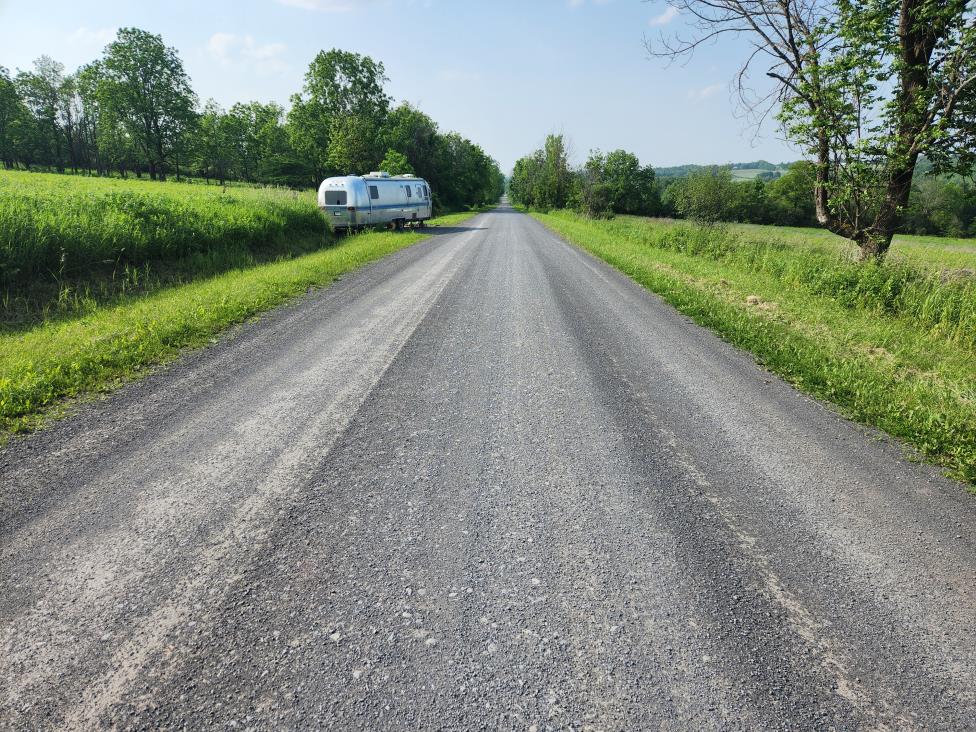
And when Enfield attempted in 2023 to cut speeds for the arguably better-surfaced Van Ostrand Road, also gravel, located on the Enfield-Newfield Town Line, NYDOT cited standing policy for its rejection.
“NYSDOT follows a practice of not posting speed limits on unpaved roadways,” Regional Engineer Bates wrote the Town that November. “Studies have shown that lowered posted speed limits on gravel roads have negligible impact on improving speeds and operations,” Bates wrote.
“It’s a dirt road, so they’re not going to do anything about it,” Supervisor Redmond lamented about Tucker Road after being reminded of the state policy. “But let’s submit it and see what they say.”
When the Breezy Meadows subdivision underwent Town Planning Board review in 2023, Enfield Highway Superintendent Barry “Buddy” Rollins determined that Tucker Road stood in adequate shape. He dismissed calls for having Tucker’s condition improved, perhaps at developer expense. Rollins similarly this past January resisted prioritizing Tucker Road’s paving, arguing that future home construction would only tear up whatever pavement Rollins’ crew laid down.
****
Amazingly, it was a full 21 months ago that the Enfield Town Planning Board handed up its draft revised Subdivision regulations for Town Board review and adoption. Wednesday, June 11, the Town Board finally finished its review and forwarded the nearly 30-page document to its attorney. A public hearing and adoption could occur by late-summer.
For meeting after meeting, perusal of the Subdivision Regulations got relegated to the bottom of long agendas, often postponed by board members either too fatigued or short-handed to wade through them.
As it’s turned out, the Town Board’s current document stands little different from what the Planning Board had initially recommended in September 2023.
Over the course of those many months, ideas got briefly raised and later discarded. A “right to water” clause, suggested after the Breezy Meadows development controversy, was offered as an amendment, but then rejected, early-on.

Later, the Town Board proposed asserting itself more actively in the approval of larger-scale subdivisions. But planners then pushed back on the idea and the attorney questioned whether dual-oversight was legal. The Town Board’s current draft would only empower the Town Board to “recommend approval or denial.” of a subdivision during preliminary review. It’s a recommendation that the Planning Board would consider as “advisory only.”
The Town Board had also once considered raising minimum lot sizes, but then opted to keep them at one-acre, subject to Health Department approval.
Most recently, last December, Supervisor Stephanie Redmond had raised the prospect of adding a control of outdoor lighting. But as its final decision on the regulations this past Wednesday, the Town Board agreed to defer any lighting regulations and consider them only later as a stand-alone law.
“If we want to do something like a Noise Ordnance, or a Light Ordinance, or a Junk Ordinance… we should do it separately,” this writer, Councilperson Lynch, advised the Town Board. Otherwise, he said, “it could make an otherwise non-controversial set of regulations very controversial.”
In other Town Business June 11:
- The Town Board formally recognized and commended long-time Enfield Food Pantry volunteer Maryanne Berlew on her 80th birthday. Berlew’s recognition followed a celebratory gathering hosted by the pantry’s parent organization, Enfield Food Distribution, the previous Sunday.
- The Town Board set a Public Hearing for its July ninth meeting to consider a local law that would opt back into a New York State statute and thus enable the Town of Enfield to directly negotiate, at least in theory, tax abatement agreements with solar farm developers. Enfield had opted-out of the law during the Black Oak Wind Farm controversy more than a decade ago, but now considers that move a bad idea. Enfield actually thought it had opted back into the law two years ago, but did so by resolution. State taxing authorities advised that a local law was instead required.
- The Board set second Public Hearing, this one for August, on what’s become an annual ritual; the override of New York’s penalty-free “tax cap” affecting next year’s Enfield budget. The state-calculated cap—not yet known for 2026—often restricts tax levy increases to no more than two per cent. Enfield’s levy increases in recent years have climbed far above that percentage. Councilperson Lynch urged the Town Board delay the hearing until the fall, until both Town budget projections and the tax cap are known. Wait until “necessity dictates an override,” Lynch said. Supervisor Redmond opposed delay. “I think necessity dictates an override, no matter what,” Redmond responded. She cautioned that even despite best efforts to keep tax increases under the cap, “if you go over it, you’re out of compliance.”
- And with little discussion, the Town Board declined Councilperson Lynch’s annual effort to have the Town reclaim for its own purposes the local share of sales tax revenue that Enfield has for more than a decade allowed Tompkins County to keep to reduce its own county tax. The practice leads to a county tax calculated disproportionately low on residents’ tax bills and a town tax that’s disproportionately high. But it also inflates the abated tax revenues solar farms pay. “I’m not going to support that,” Supervisor Redmond said of the sales tax reassignment. “Make those solar farms pay.”
###
One Big, Burdensome Building
Tompkins legislators commit to fund Center of Government, build it Downtown
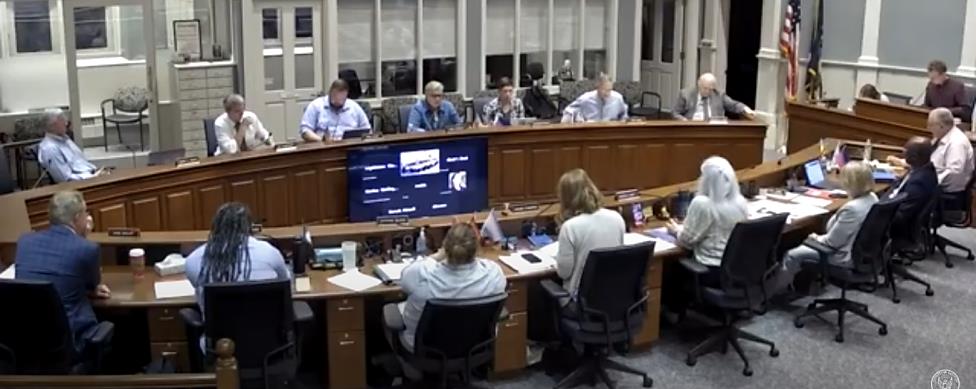
By Robert Lynch; June 4, 2025
“What’s the worst-case scenario? How much is this going to raise my taxes?
Tompkins County legislator Lee Shurtleff
“We don’t know yet.”
Tompkins County Administrator Korsah Akumfi.
****
They debated. They voted. They waited briefly for self-congratulating applause. No one clapped. That should tell us a lot.
Driven by exhaustion, exasperation and anxiety far more than by excitement, the Tompkins County Legislature late Tuesday approved its firmest-ever commitment to build a new Center of Government and to build it in downtown Ithaca.
By a nine-to-four vote, following more than a full hour of discussion, legislators endorsed a resolution June third closely aligned with one recommended earlier that day by an oversight committee. The Legislature approved funding up to $50 Million to construct the mammoth new building on downtown land that the county bought for the project nearly four years ago.
The four-story (or higher) office structure adjacent to the Tompkins County Courthouse and DeWitt Park would shelter departments either scattered around Ithaca currently or cramped in undersized facilities on the County’s so-called “downtown campus.”
“We have been talking about this for at least six years,” one of the exasperated, Lansing legislator Deborah Dawson, observed as she criticized the sluggish progress that’s dogged the building project for a half-decade. “And the reason that the price keeps going up is because we keep talking about it. Nothing gets cheaper.”
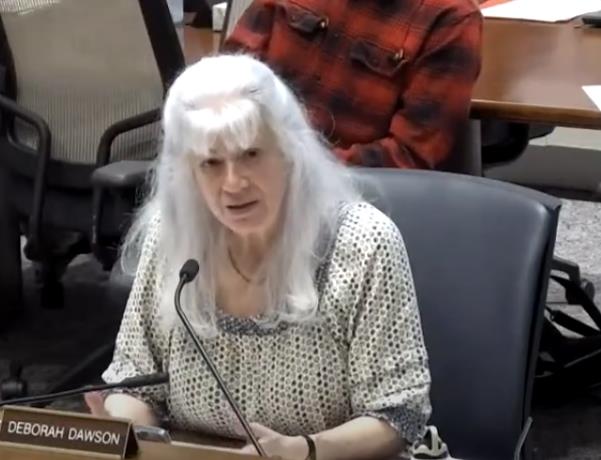
All three legislative Republicans, plus Ithaca Democrat Travis Brooks, voted against the resolution. Among those dissenters was Newfield-Enfield legislator Randy Brown, who’d earlier in the day supported a nearly-identical measure unanimously recommended by the Legislature’s Downtown Facilities Special Committee. Brown chairs the committee.
In one way or another for much of this millennium, Tompkins County officials have advanced the Center of Government concept. Latest chapters in that quest reach back about seven years. As the pages turn, the price always goes up.
The latest cost estimate for the building’s design, construction, furniture purchases, and related expenses, together with subsequent repurposing of existing facilities, has grown 25 percent just in recent weeks. Projected cost had been $40 Million. By contrast, when the County Legislature pulled the Center of Government idea from years-long dormancy in early 2019, the estimated cost had been pegged at no more than $18.5-19.5 Million.
Do the math: More than 2.5 times the cost to construct the building now rather than then. Who thinks inflation will stop?
In committee Tuesday, Dryden legislator Mike Lane, the body’s longest-tenured lawmaker, hinted at a project cost of $60 Million. Still another trusted source warned the price could climb to $75 Million.
And during the eight hours between the Downtown Facilities Committee’s vote and committee member Anne Koreman’s bringing her modified resolution to the Legislature’s floor Tuesday night, the building’s footprint had grown from 45,000 to 48,000 square feet. (It was explained that the architect had forgotten to provide for hallways and stairwells.)
Yes, full legislative action on the committee’s recommendation could have waited. Maybe, it should have. But the persistent impatience of newly-named Tompkins County Administrator Korsah Akumfi—on the job for only four-and-a-half months—has prodded the Legislature to act sooner rather than later.
“There needs to be a commitment. There is a need for that commitment to be made right now so that we can continue with the project process and not look back,” Akumfi advised the Downtown Facilities Committee when it met in the morning.

“This resolution is not a binding document on any contractor terms or anything,” Akumfi informed committee members. “It’s just a direction from all of you to tell us that there is a commitment for us to move the project forward.”
This month’s rapid-fire rush to commit financing to the Center of Government marks the first significant legislative promise to proceed with it since the County Legislature in September 2023 passed a “Resolution to proceed with space, architectural, and engineering plans” for the project.
The 2023 resolution authorized Tompkins County to “proceed with plans” for the building and to solicit a design consultant. The legislature found that architect and has since invested at least nine million taxpayer dollars toward designs and land acquisition.
But the degree to which Tuesday night’s action locks in Tompkins County to putting its money where lawmakers’ mouths rest depends on whom you ask.
Questioned whether the resolution required a larger-than-usual majority because it commits money, County Attorney Morey Josephson said it did not. “It’s aspirational as opposed to a fixed expenditure,” Josephson explained.
But later, Deputy County Administrator Norma Jayne took a different position.
“What I believe is happening with this resolution is we are committing funding,” Jayne said of the resolution’s impact. “If you vote for this tonight, you are committing to spending money at some time down the road in the next few years because you can’t start the project without planning to continue it, seeing it through.”

Korsah Akumfi’s insistence on a firmer financial commitment appears driven by his new-on-board observation that decisions toward building a Center of Government have been too tentative, made without financial promises to undergird them.
Akumfi’s own Administration Department will relocate to temporary quarters across town in coming weeks so that the office of Information Technology can briefly occupy the third floor of the “Old Jail” while I.T.’s current home readies to be torn down. To enable the Center of Government’s construction, three existing structures, including “Building C” on East Buffalo Street, where I.T. resides, must be razed. Schedules call for Building C’s deconstruction by late-winter.
Timetables envisioned by the project’s consultant, Holt Architects, predict groundbreaking for the Center of Government in January 2027, with its completion in November or December of 2028. A subsequent renovation and repurposing of other County offices would follow.
But the rapidly escalating cost of all this new work worries some, particularly the legislators who opposed Tuesday’s resolution.
“I tried to pinpoint the cost of this,” Randy Brown said, saying he’d talked with Holt’s design team. ”And they just don’t know. They don’t want to commit to anything.”
“I’m hearing two things; it’s not a commitment, but it is a commitment. And it signals that we’re going to go ahead,” Groton’s Lee Shurtleff, another of the dissenters, said.
But Shurtleff has multiple worries. Sales tax revenues are flat. Property assessments aren’t rising as they were. “Sin tax” revenues are “negligible,” he said. Investment income is declining. Reserve funds need propping up. And future state assistance remains all too uncertain.
“I can’t in good conscience support tagging that number ($50 Million) not having a better idea of what the implication on the future tax rate may be,” the Groton Republican concluded.
So Lee Shurtleff sought the tax impact answer as best he could and got a response less-than-assuring.
“What’s the worst-case scenario? Shurtleff asked Administrator Akumfi. “How much is this going to raise my taxes? Do we have an idea how to answer that?”
“We don’t know yet,” Akumfi responded. Tax impact depends on variables, like bond interest rates. It’s a “combination of many factors,” Akumfi said.
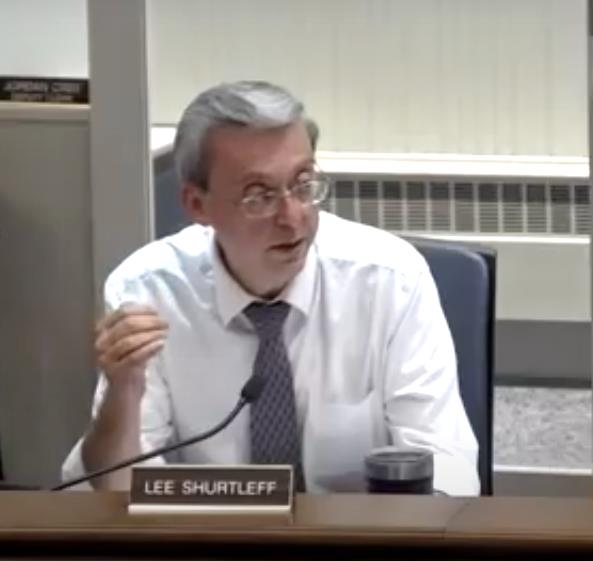
Dryden’s Greg Mezey guesstimated that project bonding could hike the tax levy by about four percent.
But while Shurtleff expressed reticence, Democrat Amanda Champion had grown impatient.
“I think that if we do not pass this tonight, we should forget the whole project,” Champion insisted. Elections are this fall, she noted, and as many as nine new legislators will replace incumbents, including her. They’ll have new opinions and they could take the Center of Government “back to the drawing board,” she warned.
“And if there isn’t the desire to build a Center of Government, let’s just drop it,” Champion enounced.
As for whether the $50 Million building should go downtown or be put somewhere else, legislators have pretty much resolved to keep what they’d build putting a shadow over DeWitt Park.
“I think the ship has sailed in this,” Randy Brown said of the Downtown preference. Downtown’s prospects grew after the New York State Office of Historic Preservation (SHPO) granted its verbal consent to the existing buildings’ removal. A written confirmation will likely follow soon. “If we’re going to do anything, it’s going to be downtown.” Brown reasoned.
Deborah Dawson agreed. “If it’s not downtown, it’s going to be somewhere in the burbs, she predicted. And Ithaca is the only place that’s centrally located and reachable equitably from everywhere. “If you put it in Groton, people in Enfield are not going to be very happy,” Dawson concluded.
That said, many would reason that it’s just as easy and quick for someone in the western towns to reach the airport area or the malls in Lansing as it is to navigate Ithaca’s parking-deprived downtown streets.
Ithaca’s Travis Brooks was the only Democrat on the Legislature to oppose Tuesday’s resolution. He rattled off his reasons.
“I don’t really feel this is the best place for this,” Brooks said of the downtown site, referencing parking and traffic congestion concerns. But there’s also cost.
“I can’t believe this thing is only going to be $50 Million, especially by the time we get started,” Brooks cautioned. “I’m definitely not going to vote for it just on the fact that I don’t think it should be downtown to begin with, and it’s not going to house all of our downtown departments, and it’s not going to be $50 Million.” He predicts it’ll cost more.
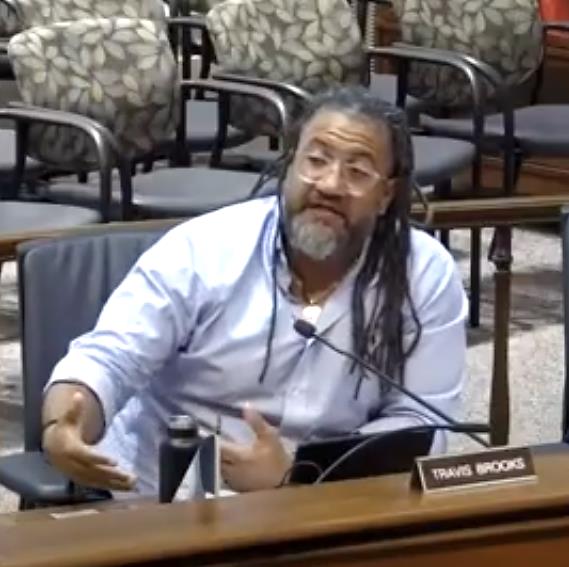
As part of its outreach effort, perhaps intended to “sell” a hefty, eight-figure construction project to reluctant residents, Tompkins County will host five “Community Engagement” meetings in various municipalities beginning in mid-June. The first will be held in Groton Wednesday, June 11, followed by a hastily-scheduled session at the Enfield Community Center, Thursday, the 12th.
A staff-scripted printout states that the Engagement Meetings’ purpose is the “documentation of community needs and priorities,” to relate “stories illustrating current challenges,” and to “identify metrics from the perspective of the community.”
Perhaps the most meaningful “metrics” would have sought answers to questions that legislators chose to answer for themselves, and by themselves, Tuesday night: Questions like, “Why build a Center of Government in the first place?” And if so, “why build it downtown?”
“If you adopt this resolution tonight,” this writer, Enfield’s Councilperson, told the Legislature during evening privilege-of-the floor comments, “you are essentially putting the cart before the horse.”
As to allowing the public to speak first, legislator Champion thought differently,. “If you have not had enough time at this point, you have not been paying attention,” the animated Ithaca legislator insisted.
But why this sudden rush to strike fiscal commitments that never held priority status a few months ago? Korsah Akumfi may be the reason. Hired away from Schoharie County late last year and haven taken office only in January, Akumfi had formerly served as County Administrator in a place governed by a Town-elected Board of Supervisors, not an independently-elected County Legislature.
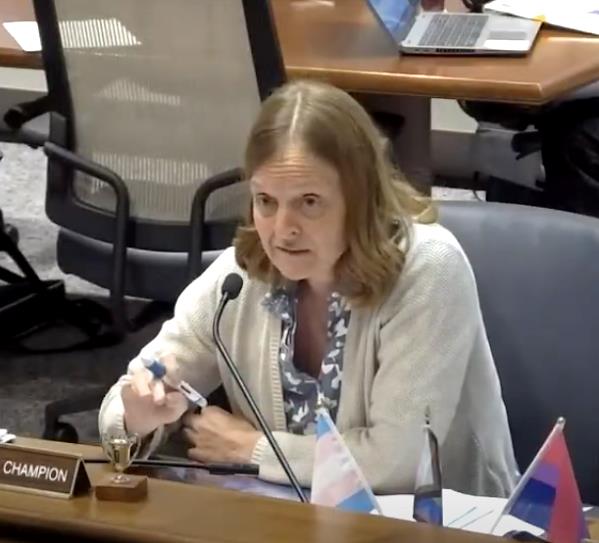
The dynamics could be different. Supervisors drawn from varied constituencies may demand more guidance and delegate more power. At times, Korsah Akumfi’s management style here has resembled that of an elected County Executive. But he does not hold that more powerful office. Over the decades, Tompkins County legislators have closely guarded their power. They remain in charge. The County Administrator answers to them, not the other way around. But at least in this instance, the new Administrator’s demand for “clarity” in the Center of Government’s path to a groundbreaking has encouraged those we’ve elected to comply with the Administrator’s request.
“It’s a big number, it’s a big commitment,” Democratic legislator Rich John acknowledged before casting his vote in favor of Center of Government funding. “But you have to do it to keep the ship sailing in the direction we’ve all talked about for all this time,” he said.
Yes, there could be “this huge surprise,” John admitted. The federal government could do something “that just destroys our fiscal condition,” John admitted. Interest rates could “go bonkers.” The Center of Government could prove unbuildable under those circumstances. And if so, John said, County Government could cancel its plans; “We can say no.”
“There’s real cost to saying no, to opting out” Rich John recognized, “but we can do that, and a responsible legislature would consider doing that, if conditions change radically.”
But for now, opting into a Center of Government, building it despite escalating cost, has become Tompkins County’s preference, and to do so whether or not those our elected leaders represent truly want it or not. Hold the applause.
****
Note: On June 5, Tompkins County announced that the location for its Thursday, June 12 Community Engagement Session in Enfield to discuss the proposed Center of Government project had been moved from the Town of Enfield facilities earlier identified to the Enfield Community Center. County officials said the relocation was to better accommodate attendees and staff. (A previous version of this story had listed the initially-designated location.) / RL
###
County proposes big EMS expansion; Bangs pushes back
Department proposal would hike a 500k annual program to $3 Million
By Robert Lynch; May 28, 2025
Improving local emergency medical services and speeding ambulance response times, particularly to patients in Tompkins County’s rural areas, has suddenly gotten a lot more complicated.

Two supposedly complimentary—though potentially conflicting—proposals that would increasingly involve Tompkins County Government in the emergency treatment and transport business got their first, individual airings May 27 before the Tompkins County Legislature’s Public Safety Committee. But after the committee’s 90-minute discussion Tuesday had ended, no clear plan emerged as to in which way emergency medical services (EMS) will actually go.
“We’ve kind of been proceeding on parallel tracks,” committee Chair Rich John observed of those choices even before staff from Tompkins County’s Department of Emergency Response (“DOER”) and Paul Bishop, Project Director of the consulting firm Center for Governmental Research (“CGR”), had taken their respective turns before the committee.
CGR asked only for money and a contract. Bishop requested County Government spend $48,000 for his Rochester-based firm to study EMS’s problems. Under his proposal, CGR would make recommendations and then outline available options to the County Legislature by September 30.
DOER’s proposal is far more concrete—not to mention ambitious. And its concept has already ruffled a few feathers along the way. DOER would expand the already existing, but now operationally modest, County-run Rapid Medical Response (RMR) service to become a backup ambulance operation of sorts.
Under DOER’s self-proclaimed “EMS Strategic Vision,” RMR’s annual spending would skyrocket five-fold.
DOER’s “Strategic Vision” would have Tompkins County buy three ambulances, increase RMR’s full- and part-time medical staff from its current six people to as many as 30 (plus Per Diem help), and grow a $546,828 budget to just over $3 Million.
“We came up with this program to help augment our current transport agencies and not replace them, Joe Milliman, Tompkins County’s EMS Program Manager, informed the committee. He joined Director of Emergency Response Michael Stitley for the May 27 presentation.
But the Rapid Medical Response program Milliman and Stitley envision to fill perceived needs and to serve its limited purpose is a far cry from how the program began and what it remains at present.

Aside from the multiples of increased cost, RMR would expand from only EMT-level “Basic Life Support” (BLS) to also include “Advanced Life Support,” (ALS), higher-level care that Stitley says requires a trained paramedic to deliver. Under the “Vision,” one ambulance would run 24/7, the second, daytimes-only. The existing service currently runs from only 7 AM to 7 PM, weekdays.
RMR was conceived and launched in April of last year after officials sensed a shortage of volunteers, a shortage that had depleted the ranks of local fire department rescue squads, particularly during daytimes. RMR presently employs Emergency Medical Technicians (EMT’s) only. It stations them one to a car, and utilizes pickup trucks and SUV’s repurposed from the County Government’s motor pool.
The current RMR service has no ambulance. Any new units purchased would provide only basic life support. DOER budgets them at $150,000 apiece.
Nowhere in its written proposal does DOER specify a start-up date. Nor was it stated at the meeting. But one infers that the transformation could take place as soon as 2026. After the committee adjourned, Director Stitley acknowledged that the service could begin as soon as next year; if not that soon, then in 2027.
The Public Safety Committee took no vote on any of the Emergency Medical Response choices Tuesday, leaving matters very much up in the air. Instead, Rich John signaled that he’ll offer a so-called “Member-filed Resolution” for the full Legislature to consider, probably in June. The member initiative would authorize some revised version of the Center for Governmental Research’s initial proposal.
We will “refine the scope,” John said of the study after the meeting had adjourned. John suggested the consultant’s fee would likely fall below the $48,000 Bishop had quoted. The chairman also assured that the study will include DOER’s expansive model among its considered options.
The Department of Emergency Response’s heretofore undisclosed proposal emerged almost from nowhere. Its first disclosure came in an attachment to the committee’s online agenda packet, posted on Tompkins County’s meeting portal a few days before the meeting. Quite likely, some in government didn’t want details publicized ahead of time.

And that reticence could be for good reason.
As Milliman outlined his department’s initiative, several officers of the privately-owned and Ithaca-based Bangs Ambulance, Tompkins County’s largest transport agency, sat in the gallery. Invited by Rich John after the presentation to come forth and speak, company president Tim Bangs and Board of Directors member Brian August took polite, though direct hits at the DOER proposal. They viewed DOER’S plan as being too costly to the taxpayer and too demoralizing to the volunteer rescue squads that have partnered with Bangs for decades to save lives.
Regarding the money, Tim Bangs asked, “For the 80 years that Bangs Ambulance has been providing that service to Ithaca and Tompkins County, what has Tompkins County paid for that? Nothing.”
“It’s hard for a private service to compete against a public entity,” Brian August stated. He reminded all that public employees receive lucrative public benefits. August feared that if RMR were expanded, some Bangs’ staff would quit or downsize to part-time so as to join Tompkins County’s workforce and then reap the benefits.
Tim Bangs advised the committee that when the RMR service launched last year, “the generic staffing level” amounted to “robbing Peter to pay Paul.” One employer’s gain was another one’s loss given the short supply of EMT’s and paramedics both in Tompkins County and across New York State.
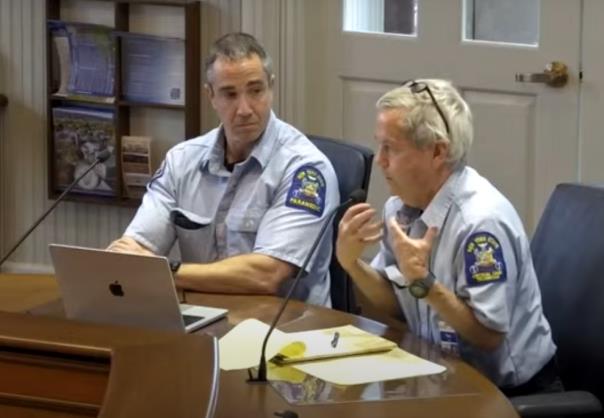
And a critical read of the staffing plan to implement the “EMS Strategic Vision,” suggests that Milliman and Stitley have employed a healthy amount of wishful thinking.
“The biggest question that we get is where are we going to get the staff,” Milliman acknowledged to the committee.
“Tapping into the local colleges,” the EMS program manager mentioned as one idea. Continuing to work with Tompkins Cortland Community College and Syracuse’s Upstate Medical Center to bring EMS training courses to Tompkins County was another the plan tossed out.
But the major expansion DOER envisions requires not just lower-level EMT’s, but also higher-skilled paramedics. Tim Bangs claimed that the nearest paramedic training schools require travel to Elmira, Syracuse, or Binghamton.
And then there’s the issue of volunteer morale; the attitudinal adjustment that comes when a firehouse volunteer learns that what he’s doing for free has become a task somebody else is doing for pay.
Tim Bangs said he’d heard the complaints when the RMR program began. Volunteers would say, “If this call comes out… and I know that the County is getting paid to go to that call, I’m going to sit in the station, and I’m not going to go because I’m not getting paid for it. I’m a volunteer. If they’re going to get paid, let them go on the call.”
Tim Bangs’ advice to the committee: “We would love to see instead of slamming the door on these first response agencies, let’s try to rebuild them.”
Yet “doing nothing is not an option,” Dryden Councilperson Dan Lamb stressed when Rich John invited outside comment. Lamb is among the select few who sit on the Emergency Planning and Preparedness Subcommittee of the Tompkins County Council of Governments (TCCOG). It was the subcommittee that in separate meetings first tapped Paul Bishop’s advice for EMS restructuring ideas, and then at a second session, heard DOER’s proposal.
This writer, Enfield’s TCCOG representative, attended the early-April session with Bishop, but was then requested by the subcommittee’s chair, Caroline Supervisor Mark Witmer, not to divulge its substance; only to recite a generalized statement Witmer had dictated. The later meeting with DOER was even more shrouded. Not even the full TCCOG membership was made aware of it when TCCOG convened May 22.
Witmer Tuesday defended his decision to keep subcommittee sessions private, arguing that the subcommittee is only a “working group,” exempt from the Open Meetings Law.
But more important than staffing, the key component to EMS’s reimagining is its cost. How will the bills get paid? If the Rapid Medical Response service’s budget is to balloon from a half-Million dollars to nearly six times that amount, who will pay the difference?
“New York State is not coming to save us,” Dan Lamb, a leader well-connected to Albany power-politics, cautioned the committee. “We’ve got to fix this on our own.” Yet how?
When funding for the current, more modestly-priced RMR program was first discussed, several cost-sharing ideas came forth. Back then, talk was that Tompkins County would pay a portion, maybe half, of the expense; local municipalities would fund the remainder. Under one option, the Town of Enfield’s share would exceed $58,000. That request later fell to $10,000, and still later dropped to zero, but only after a one-time state grant came through to underwrite the expense for 2025.
No similar lifeline will likely come for the year ahead, Director Stitley predicted after the meeting. Meanwhile, County Administrator Korsah Akumfi implied during the session that municipal cost-sharing remains very much on the table.
“It’s not worth paying for a service or a study (like, for example, Paul Bishop’s consultancy) if there’s no commitment to implement,” Akumfi said. “So we need to have that commitment from all the municipalities that we will buy into the idea so that it can be successful. Without that commitment, it will not be successful,” the Administrator reasoned.
There’s an elusive, yet pervasive unease one gets from examining DOER’s suddenly-surfaced prescription to Tompkins County’s EMS crisis, if indeed a crisis truly exists. One perceives a proposal slapped together too fast and founded on too many impulsive assumptions. And one discerns a plan that grants all-too fleeting consideration to the all-important bottom line: the money.
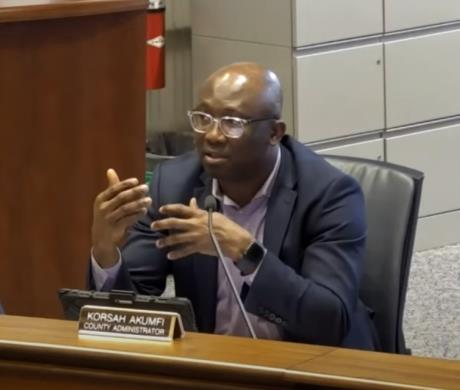
Public Safety Committee members grasped that unease Tuesday. And the deeper one digs into the Milliman-Stitley vision statement, the more essential Paul Bishop’s more detached perspective may prove advisable. An experienced consultant may find holes in the plan ready to poke.
Example: DOER wants Tompkins County to buy three ambulances. Paul Bishop’s reality check: “If you were to order an ambulance today… you wouldn’t see it for two, two-and-a-half years, if you wanted a new one.”
Or staffing: “It’s harder to find EMT’s and paramedics than it was even three or four years ago,” Bishop provided.
Sometimes, third-party expertise is worth what you pay for it. Chairman Rich John and the Public Safety Committee seemed to grasp that concept Tuesday.
Nevertheless, the Department of Emergency Response’s “EMS Strategic Vision” has its well-placed cheerleaders. They include Dryden’s Dan Lamb and Trumansburg Mayor Rordan Hart. Both leaders have professionally-paid municipal ambulance services within their towns, and both sit with Caroline’s Witmer on the TCCOG Emergency Preparedness Subcommittee.
“From the standpoint of the Village of Trumansburg, we strongly, strongly support the notion of the expansion of the RMR program,” Hart emphasized to the Public Safety Committee. “For me, this is really a public policy question, not an EMS or EMT operational or a structural question,” Hart stated.
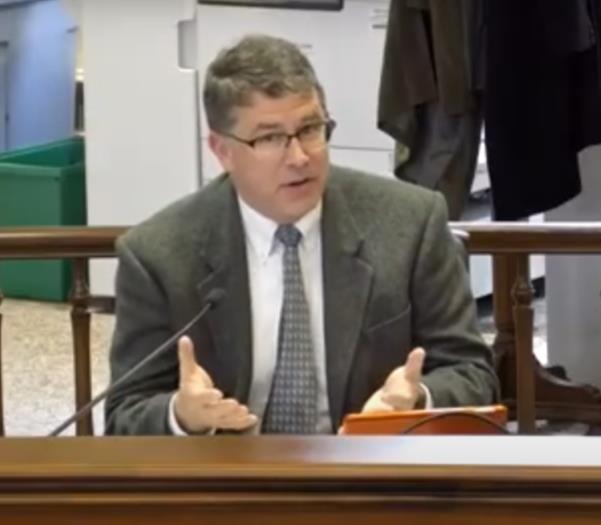
Mayor Hart would have Tompkins County treat EMS like it does law enforcement, consider it a department like that of the Sheriff, and budget the service accordingly.
As many of 26 percent of Trumansburg Ambulance’s calls go to places outside of T-Burg’s service area. Many gap-fill for Bangs. And many calls lose money. That out-of-area rate stands as high as 40 percent in Dryden.
“The thing that we can’t do is wait another year on this,” Dryden’s Lamb told the committee, “because my taxpayers are kicking in about a half-million dollars a year going outside of my town, and that’s a really hard thing for me to justify to the people that I serve.”
That said, equally hard to justify for anyone in Enfield government would be appropriating some large annual sum—maybe in the six-figures—as the local “cost-share” for a County-run, stand-by service that some may say duplicates work of the already well-equipped Enfield Volunteer Fire Company’s Rescue Squad.
But for those who might think that way—perhaps including Tim Bangs—Mayor Hart counters they’re living in the past.
“There isn’t in my opinion a way to make Tompkins County 1985 again, for lack of a better phrase,” Hart told the committee, “and resurrect a volunteer first response situation that simply doesn’t exist anymore.”
Then again, if Mayor Hart stands correct, where does all that new money come from; three million dollars of new money? No one’s offered that answer yet.
###
The Flood Law leaders like, locals don’t
Enfield regulations impair our freedom, critics charge
by Councilperson Robert Lynch, May 26, 2025
“I don’t think anybody wants flood insurance. What they want is to be able to get a mortgage.”
Enfield Supervisor Stephanie Redmond, Town Board meeting, May 14.
“It seems like a bunch of bull to me.”
Enfield landowner John Rancich, same meeting.
****
Rosanna Carpenter’s and Rodger Linton’s log home lies at the edge of—but just beyond—the newly-designated Enfield flood prevention zone. You need to cross a private bridge to reach their residence. Carpenter and Linton maintain that bridge. They also own land each side of it, vacant fields that could someday sprout new houses, if only government will tell someone it’s OK to build there.
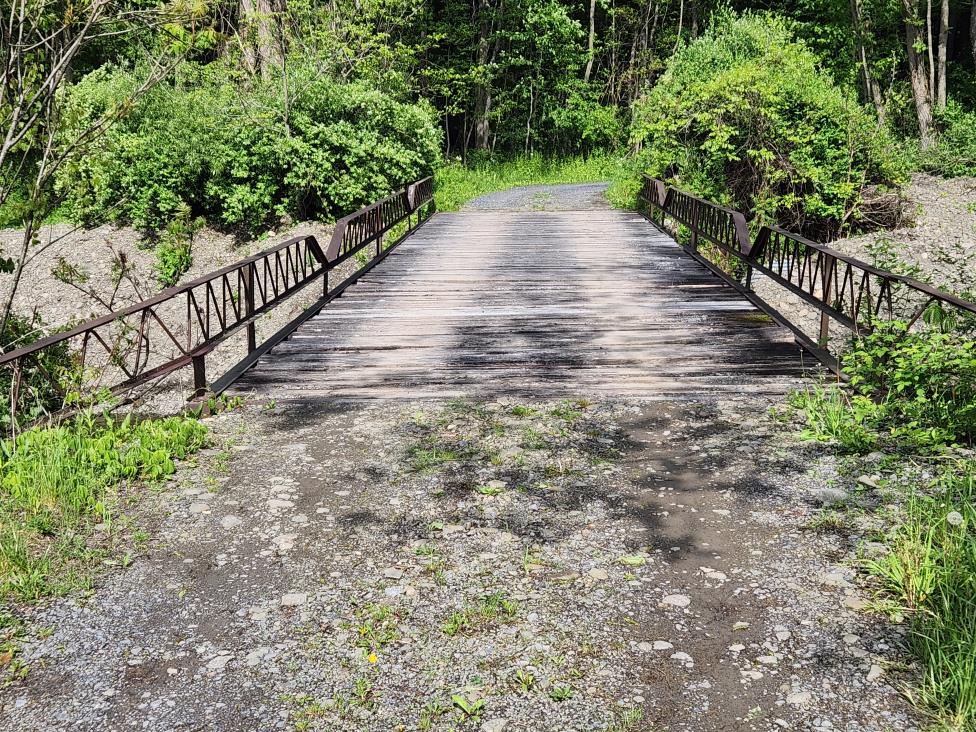
Right now, Carpenter and Linton are angry. And they brought their discontent to the Enfield Town Board earlier this month. Others living or owning land in the flood plain did so as well. They didn’t like what the Town Board did that night.
Federal and state authorities last year decided that a narrow strip of lowland along Enfield Creek could someday get flooded, even if no more often than once in 100 years. And because of that remote risk, state officials successfully strong-armed the Town Board May 14 to enact new, stringent flood plain development controls in what they call the “area of special flood hazard.” New buildings there could have no basements, and many might need to be built on stilts.
The tighter rules accompany Enfield’s forced participation in the National Flood Insurance Program (NFIP). Federally-supported flood insurance will be available to all Enfield homeowners as of mid-June.
People like Carpenter and Linton argue that neither the regulations nor the insurance is needed, and that the government controls smack of first-ever, Enfield zoning.
Flood insurance rates run three-times the average of a homeowner’s policy, Carpenter said at the May 14 Public Hearing called to address the proposed law. The hearing ran just five minutes short of an hour and filled nearly all the room’s chairs. “So if you have a $2,500 policy on your home, it’s going to cost you $10,000 a year to take the chance that you might get flooded,” Carpenter estimated.
“Has anyone ever drowned in this town from a flood?” Linton asked rhetorically. “Has anyone even been made sick from a flood, ever? Can anybody answer that question for the Board?”
This Councilperson said he couldn’t recall any deaths. The criticism continued.
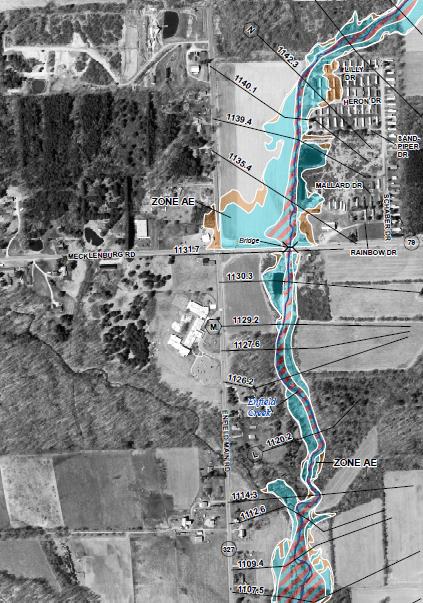
“My apartment buildings are in the flood plain. They’ve been there for 35 years, and I’ve not had any floods” John Rancich, Enfield’s best-known landlord, informed hearing attendees. “I’ve had the creek come up a little bit, but there’s never been a flood.”
“It seems like a bunch of bull to me, and the town doesn’t need flood insurance,” Rancich asserted.
Need it or not, federally-backed flood insurance will soon become available to every Enfield homeowner. And a few residents may even be forced to buy it.
The Town Board’s adoption of the controversial regulations May 14 fulfills a federal and state requirement that governmentally-backed—and yes, pricey—flood insurance be made available to everybody in Enfield now that federal and state regulators have identified a flood-prone place in the Town. That strip along Enfield Creek may be small. It includes only a handful of houses. Nonetheless, its existence suffices for the government’s mandate to kick in.
The leverage government holds is that as of mid-June anyone owning property within the flood plain will need to purchase flood insurance to qualify for a new, federally-backed mortgage or to hold onto a mortgage already held. The mandate covers financing from any bank insured by the Federal Deposit Insurance Corporation (FDIC).
The Town Board’s vote to adopt the Flood Damage Prevention Law was four-to-one. Councilperson Robert Lynch (this writer) cast the only dissent and took pains to explain why he’d done so.
“There wasn’t one person at this meeting tonight, at the public hearing, who said they want to buy flood insurance, not one” Lynch took note. “And I didn’t hear any person who said, ‘I’ve got a federally-backed mortgage and I need to buy flood insurance.’ I didn’t hear that either.”
Instead, Lynch said, “I heard people saying if I’ve got a federally-backed mortgage, and I’m required to buy flood insurance, I’m going to get financing somewhere else. That’s what they’re saying. I’ve gotta’ listen to what the public says.”
Town Supervisor Stephanie Redmond took a different view. “I don’t think anybody wants flood insurance,” the Supervisor asserted. “What they want is to be able to get a mortgage. That’s the reality of it. It’s hinging on a mortgage.”
But the public’s mood of the night was anger. Quite plainly, what came from the visitors’ gallery was defiance.
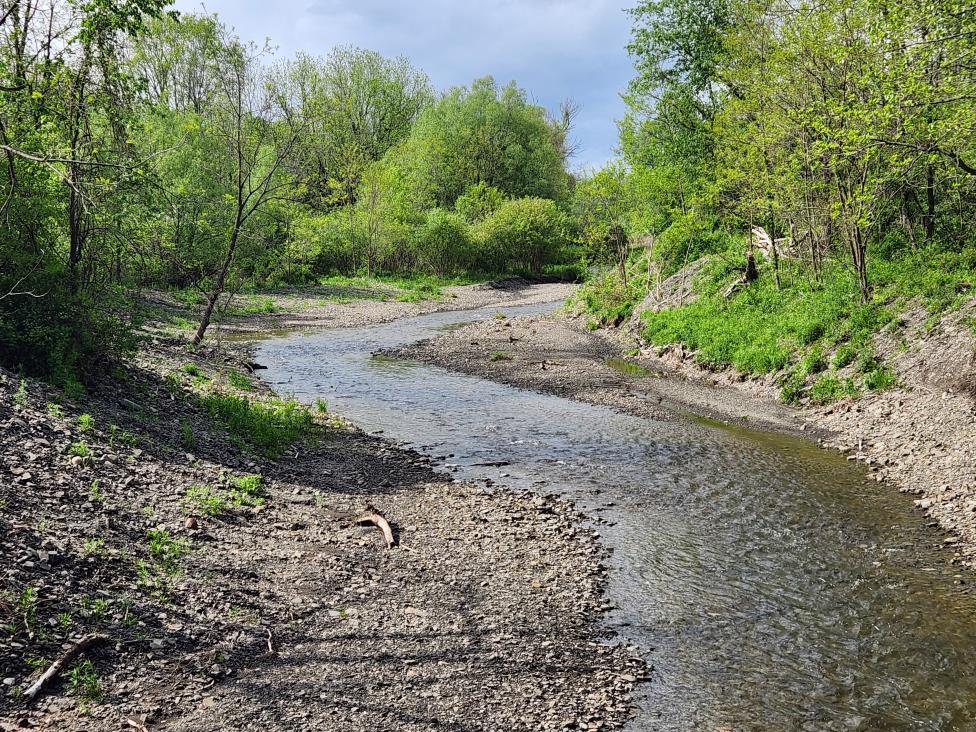
“You’re condemning people’s property,” Roger Linton asserted. He zeroed-in on a stronger-than-state-requirement that Enfield had initially proposed—but later in the meeting withdrew from the law—that would have banned any new residential construction within the flood zone. “You’re making their property worthless,” Linton admonished the Town Board.
“I’ve not heard anything here or what I’ve read that’s going to help anybody in this town,” Marie Vandemark, whose family owns Sandy Creek Mobile Home Park, said. Some of Sandy Creek’s manufactured homes rest within the flood plain.
“Look, boilerplate or not, you do have some power here; you do have a small voice, and I would love to see you all, individually or as a collective group, say, ‘Look, State of New York, or whoever you’re talking to, this isn’t really suited to our town. We have a very small population, and a small group of residents that are going to be affected,’” Vandemark said.
Other voices joined her. “Now they’re going to pass a law about flood insurance that I’m going to have to buy that I don’t need,” landlord Rancich lamented. “It’s no big deal to me. I’ll just raise my rent. And so, once again, there’ll be more cost to people that are renting my apartments, because the Town wants flood insurance that they don’t need.”
“We’re asking you to fight for us,” resident Donald Head instructed the Town Board.
“There’s nobody here in favor of this,” Linton informed Enfield’s lawmakers. “I haven’t heard one single person speak in favor of this. They don’t want it… Stand against it.”
“Go into violation,” Rancich dared the Town.
“If we don’t adopt the law, then the Attorney General of New York can come in and force us to adopt the law,” Councilperson Jude Lemke cautioned. Of anyone that evening, Lemke offered the harshest prediction of state retribution. A lawyer herself, Lemke relayed advice from the attorney for the Town, Guy Krogh.
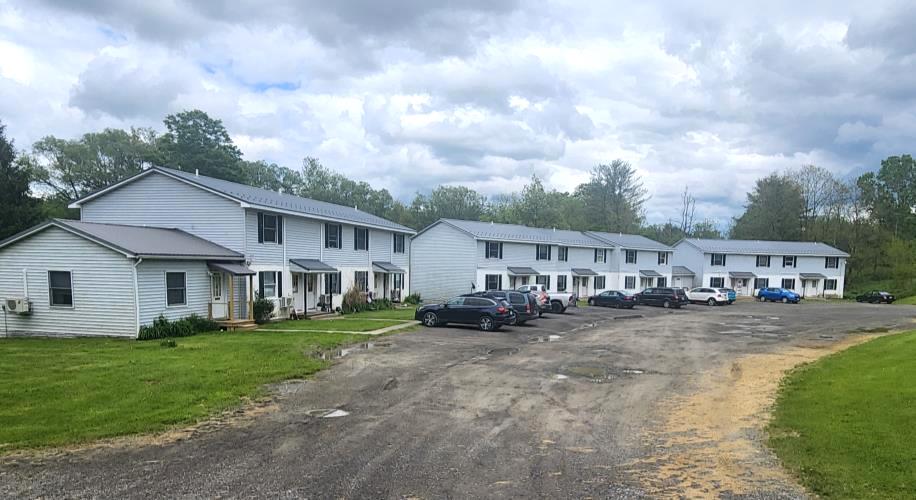
A plain reading of statute, on the other hand, provides a more benign interpretation of potential punishment. True, New York Environmental Conservation Law does prescribe that a town like Enfield, newly-designated with a flood hazard area, must “promptly… apply for and complete all requirements for participation in the national flood insurance program.”
But the “sanctions” meted out for non-compliance under that same article of conservation law fall short of the draconian punishments Lemke quoted from attorney Krogh. Statutory sanctions, the text states, limit themselves to the inability for residents to secure FDIC-backed mortgages, and, the law states, “in areas of special flood hazard, ineligibility for flood disaster aid.”
Obvious to many, Councilperson Lemke attempted to read the penalties more expansively, implying a wider, town-wide impact. At one point, she inaccurately warned that failure to adopt the Enfield law could place everyone’s home mortgage at risk of cancelation. Lemke later corrected herself.
“We as a Town and the residents of the Town will not be able to apply for federal funds if there’s a presidential disaster declared that we will not be able to participate in and get funds from the federal government, not just for floods, but for any federal disaster,” Lemke said.
The lawyer-Councilperson relied heavily upon an email circulated to Board members only hours before the meeting and signed by Kelli Higgins-Roche, New York State Coordinator for the NFIP. Some Town Board members (including this writer) had not read Higgins-Roche’s letter. But a careful reading of that letter afterward suggests some meeting night exaggeration. The NFIP coordinator’s admonitions confine themselves to mortgage availability and to grants and disaster aid specific to “identified flood hazard areas” or to municipal flood prevention in general.
In many ways, a healthy dose of misinformation circulated about the meeting room that Wednesday night.
“People who are in the flood hazard zone will be required to purchase the flood insurance,” Councilperson Lemke stated at the hearing’s start.
Not so. No property owner in the flood zone, including Stoney Brook Townhouses’ owner John Rancich, will be required to buy flood insurance, unless he or she holds a federally-backed mortgage, one that the bank is forced by the feds to insure.
“This has an impact on the Town as a whole,” Lemke continued. “It will limit our ability to receive any funds from the federal government.”
Any funds? That’s an ambiguous assumption. Higgins-Roche’s letter does not state such a categorical denial, unless the funding relates to flood relief and mitigation.
Town Supervisor Stephanie Redmond cautioned that failure to adopt the regulations could imperil an already-awarded grant to a near million-dollar culvert project for Bostwick Road, and also to a forthcoming application to replace a second culvert, its location under Rumsey Hill Road. Still, the Bostwick Road replacement is state-funded, not federal.
“There are no direct fines imposed on the communities for not complying with [Article 36 of Environmental Conservation Law],” Higgins-Roche conceded, “but there may be other grants at a state and federal level that the Town would be ineligible for due to lack of NFIP participation.” She did not specify the endangered state grants.
Let’s “strip this law down to its skivvies,” this Councilperson indelicately stated. Before its final vote, the Town Board adopted two, separate amendments to the Flood Damage Prevention Law. First, it removed the absolute prohibition on new residential dwellings in “areas of special flood hazard.” Then, the board similarly excised a prohibition on placing new manufactured homes in flood zones. As amended, the Enfield law stands no more restrictive than New York State’s model ordinance.
The number of properties within Enfield’s flood zone varies based on whom you ask. The NFIP coordinator puts the number at “about 20.” A Tompkins County Planning Department spreadsheet lists only six. Town Clerk Mary Cornell said she’d notified about eight people.

“The public is not fully informed about what you guys are doing,” Carpenter complained. “No one knew anything about this law,” she alleged, after having gone door-to-door. “You can’t pass a law that they don’t even know about,” Carpenter scolded the Town Board.
Town-wide flood insurance availability and the individual mortgage protections that hinge upon it became central arguments to flood law supporters during board member debate.
“Anybody in this town can buy flood insurance, if we participate in this program, whether they’re in the flood zone or not,” Lemke stressed as she promoted the new law. If the Town declines participation, flood protection policies won’t be available to those on high ground or low, she said.
“They haven’t been able to buy flood insurance now, before the designation, because we weren’t an NFIP member,” this Councilperson reminded his colleague. So nothing much would change for most people.
“So if anybody was close to a flood plain and wanted to buy flood insurance, they would not be able to unless we adopt this,” Lemke answered.
“And I don’t hear anybody saying they want to buy flood insurance,” Lynch rebutted. “But I’m hearing a lot of people say we don’t want the regulations.”
Town Supervisor Stephanie Redmond was home ill, but she zoomed in to participate minimally and to vote. Redmond directed her concerns to the mortgages, and her pointed criticism to this writer-Councilperson.
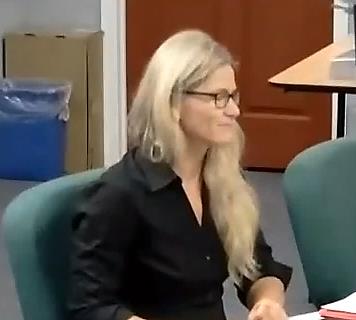
The Supervisor worried about people in the flood zone who hadn’t known of the hearing, about those who might suffer unplanned hardship and later need a mortgage they couldn’t then secure for lack of insurance; and about those whose relative may die and force a home’s sudden sale.
“And I’m sorry, but people aren’t walking around with like $300,000 of cash on hand,” Redmond said.
“Yeah, I understand why people don’t want to all of a sudden, you know, be in a flood zone, but the reality is they are in a flood zone… and there’s nothing this Town Board is going to do to make it not a flood-zone,” the laryngitis-stricken Supervisor said with what little voice she could draw forth.
“But where are they tonight?” this Councilperson, Lynch, queried. “They aren’t in this room. None of them are here. The people who were here say we don’t want the regulations.”
“But we have an obligation to all the residents of the Town, and we have an obligation to uphold the state law,” Lemke interjected.
More than an hour after the hearing had ended, and after the Town Board’s own 20-minute discussion had run its course, the clerk called the roll, and Councilperson Cassandra Hinkle, quiet through most of what had transpired, waived off casting the first vote. Only after Supervisor Redmond had voted her own affirmation did Hinkle do so as well.
“Honestly, I hate this too,” Hinkle said of New York’s strong-arm mandate. “It is the state coming down on us for it. So what could we do as an alternative? Fight it as Enfield? No. To what end?”
“Freedom! Property Rights!” two voices erupted from the gallery.
“People are going to lose their house. They’re going to lose their mortgage and lose their house,” Redmond reacted from her virtual perch on the big screen. “That’s no freedom. That’s unhoused.”
###

